- BOAT OF THE YEAR
- Newsletters
- Sailboat Reviews
- Boating Safety
- Sails and Rigging
- Maintenance
- Sailing Totem
- Sailor & Galley
- Living Aboard
- Destinations
- Gear & Electronics
- Charter Resources
- Ultimate Boating Giveaway


How to Paint Sailboat Decks
- By Tom Zydler
- Updated: March 14, 2013
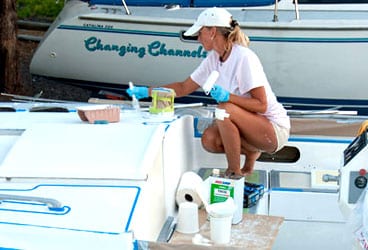
Painting a sailboat
Janet Van Leuwen and Steve Van Wig own a Whitby 42. Looking at their beautiful, well-groomed ketch, you’d never guess it was built in 1982. The name on the stern, Lunacy , may be the only hint of the incredible amount of work that the couple has put into rejuvenating their boat. Bringing the decks and the coachroof top to their present glory was a large part of the project, as these tasks would’ve been on any glass boat more than 25 years old. This is how they did it. And frankly, this is how it should be done.
Before the couple could begin doing any prep work for painting, the deck hardware had to be removed. They needed access to tight spaces where the horizontal deck surface turned into vertical bulwarks, around the masts’ partners, near the windlass base, and so on. (They also removed the chainplates, which needed attention as a separate project.) Out came all stanchions, their bases, various padeyes, winches—anything and everything, in fact, that could obstruct the power sanders required to remove the worn-down, cracking, original nonskid pattern. Steve then used silicon sealant to plug all the fastener holes that would be reused; silicon repels paint, so the fastener locations would be visible when they began reinstalling the hardware.
Donning breathing masks and kneepads, the couple spent days grinding the old surfaces with 80-grit discs. Using thick foam pads on machines running at high rpm prevented any gouging in the laminate. Smaller sanders (both round and square) helped them to negotiate tight turns; at times, they resorted to manual sanding blocks. Working with thickened polyester and epoxy resins, Steve filled several hairline cracks and dings. They then sanded this filler with 80-grit, then 100-grit, and finally 120-grit sandpaper to achieve a smoother surface before vacuuming up all the accumulated dust.
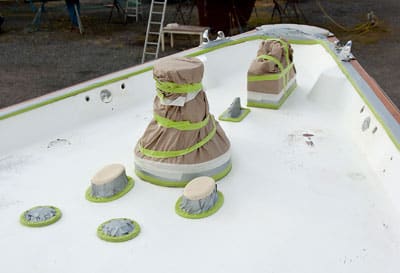
Next, to keep paint drips off teak handrails, the windlass, and the portholes, they masked these with heavy paper and tape. Right after the final wipe with a cleaning solvent, they took two days to roll and brush on two coats of epoxy primer, the base for the final topcoat. Over the next few days, the primed surfaces were sanded with 120-grit paper, followed again by vacuuming and hosing the resulting dust. Afterward, Janet cleaned all the surfaces with non-sticky tack cloths designed for multipart polyurethanes.
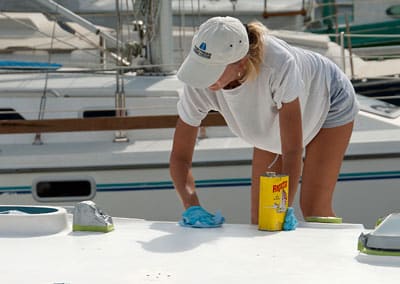
At this juncture, Steve identified and outlined the future nonskid areas, then spent a couple of days taping their inner edges with long-life 3M masking tape. At the corners, joining short lengths of tape on tight curves required meticulous care. After they wiped everything with cleaning solvent, they applied the first coat of multipart polyurethane to all the surfaces outside the future nonskid. Two more topcoat applications followed within allowable, 16-hour intervals. After sanding with 220-grit paper, dusting, using the tack rag, and wiping the solvent, they rolled and brushed on the fourth and final topcoat. The solvent-resistant, ultra-smooth, high-density foam-roller covers and quality brushes delivered the best finish. Working in the hot Florida sun required frequent additions of brushing reducer.
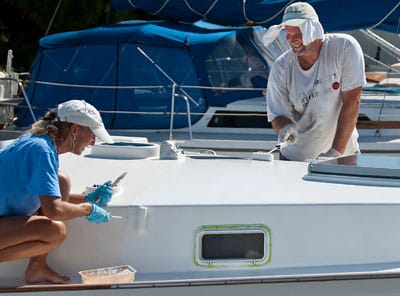
After allowing 48 hours to fully cure, they removed the masking tape. Fresh tape was then applied along the outside margins of the nonskid areas. All was ready for applying the nonskid coats. But first Steve spent a few days experimenting. He mixed his own color tints—too dark, and you couldn’t walk barefoot on the sun-heated deck; too white, and the deck glare was intolerable.
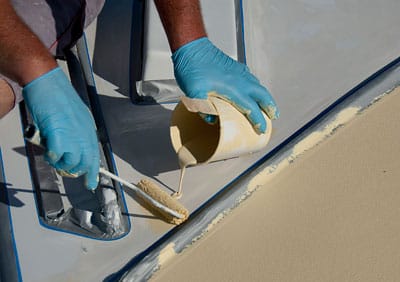
Also, he tested paint combined with various nonskid additives on scrap plywood; very coarse grit could damage human skin if a sailor knelt or fell on deck. He decided to combine equal amounts of coarse and fine grit. Significantly, this mixture prevented the coarse grit from settling down in the paint in lumps. On the big day, Steve and Janet mixed the activator with the paint base in a large container, added the correct nonskid grit, poured in the brushing reducer, and thoroughly stirred it all. After pouring small dollops within a taped area, Steve spread it out with a roller with Janet assisting, adding more paint or grit as necessary. She also wiped up Steve’s occasional paint drips with a solvent-soaked rag. The work went quickly and smoothly, though constant stirring of the paint/grit mixture was absolutely vital.
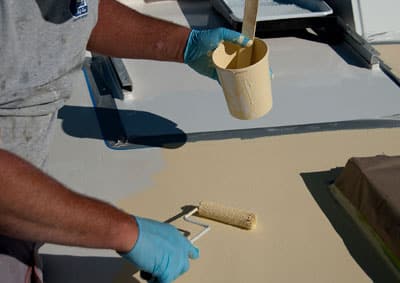
Twenty-four hours passed before heavy, late summer rain rolled in. By then, the paint had cured hard, and the coachroof was finished. They then repeated the whole operation to paint the deck. Nobody said rejuvenating a classic-plastic yacht would be quick or easy. But when the entire project was finished and Lunacy ‘s deck sparkled, the two sailors realized that all their meticulous efforts had been well worth it.
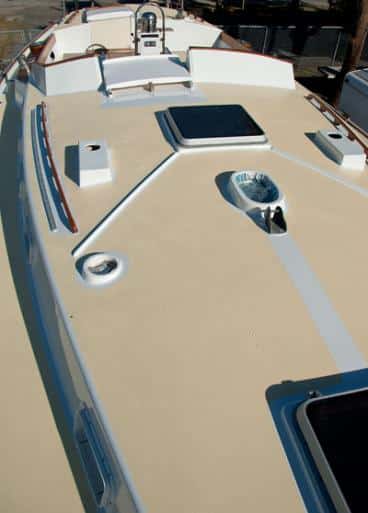
Steps:** 1. In preparation for the job, much of the deck hardware, including the stanchions, had to be removed. The remaining gear was carefully and completely covered and masked. 2. All the fastener holes were filled with silicon sealant, and the couple spent days grinding the old surfaces. Then Janet used a solvent wash to ensure a strong bond with the primer paint. 3. After dings and cracks were repaired and sanded, two coats of epoxy primer were applied. 4. Following another round of sanding, vacuuming, cleaning, and taping, the couple rolled and brushed on a fresh coat of Awlgrip topcoat. 5. After four coats of Awlgrip, it was time for the nonskid. First, Steve experimented with colors and grits. Once under way, he poured on a dollop of pre-mixed paint and spread it evenly. Note the paint stirrer, which was used to prevent the grit from settling. 6. Stirring frequently, to make sure the coverage was even in each masked area, Steve worked quickly and efficiently while Janet addressed small splashes with a solvent-soaked cloth. 7. Voilà! Once the masking tape was removed, the fresh decks fairly glistened.
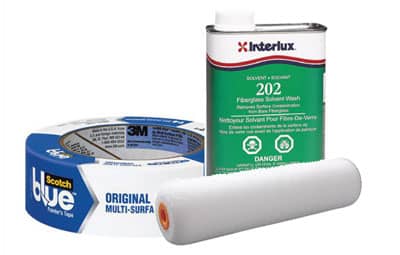
What You’ll Need: • Hook-and-loop sanding discs, sized to fit the sander pads • Sheets of sandpaper of grits 80, 100, 120, 180, 220, and 320 • 3M masking tape in widths of 1/2 inch (No. 256), 1 inch (No. 2090), and 2 inches (No. 225) • Gerson synthetic tack cloths • Roller frames and roller covers, with phenolic cores: ultra-smooth, high-density 4-inch and 6-inch roller covers (available from Home Depot; for the primers and topcoats) and Yellow stripe 3/8-inch nap (from West Marine; for the nonskid paint mixture) • Good-quality varnishing brushes • Cabisil (colloidal silica) thickening agent for making fairing putty with epoxy or polyester resin • Plastic putty knives • Interlux Fiberglass Solvent Wash 202 (for cleaning surfaces) • M.E.K. solvent (for cleaning all brushes) • Disposable paper/plastic pails of various sizes • A dozen wooden paint stirrers • Interlux Epoxy Primekote • Awlgrip topcoat (with Brushing Reducer and brushing converter) • Awlgrip Griptex nonskid additive (fine and coarse grades) • Ryobi and Makita random orbital sanders • Ryobi 6-inch palm polisher (used with a foam pad as a sander in complex spaces) • 3M breathing dust masks, ear protection, and solvent-resistant gloves
Longtime CW contributor Tom Zydler and his wife, Nancy, plan on spending this summer exploring the coast of Labrador aboard their Mason 44, Frances B .
- More: boat maintenance , How To , maintenance
- More How To

Grease the Wheels of Your Boat: A Guide to Proper Lubrication

A Bowsprit Reborn: A DIY Renovation Story

Rigging Redo: Our Switch to Synthetic

Top Tools for Sailboat Cruising: Must-Have Gear for 2024

Galápagos: A Paradise Worth the Paperwork

Around Alone

- Digital Edition
- Customer Service
- Privacy Policy
- Terms of Use
- Email Newsletters
- Cruising World
- Sailing World
- Salt Water Sportsman
- Sport Fishing
- Wakeboarding

Boating Basics Online is reader-supported. When you buy via our links, we may earn a commission at no cost to you. Learn more
The Best Boat Deck Paints for Non-skid, Fiberglass & Wooden Deck
Written by J. Harvey / Fact checked by S. Numbers
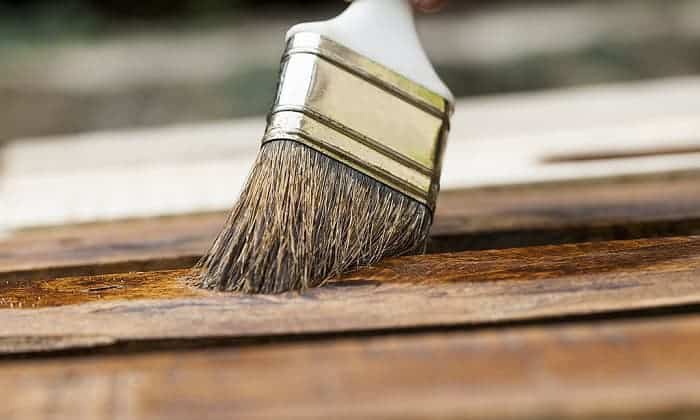
No thanks to harsh elements like wind, rains, and extreme heat and cold, any boat is bound to show signs of wear and tear over time. Nowhere is this depreciation more obvious than in the paint coatings on our vessel, on the decks we regularly trudge. What’s good is that there’s always a remedy for a beaten up deck that’s becoming unsightly and deteriorating. There’s nothing that the best boat deck paint can’t polish up in no time. The icing on the cake is that these coats do more than beautify a boat. Some naturally impart non-skid perks that would make any Navy sailor green with envy. Others add years to your boat’s life by making it waterproof and dustproof. A few marine deck paints can even deliver all these things altogether, as proven by this review and buying guide.
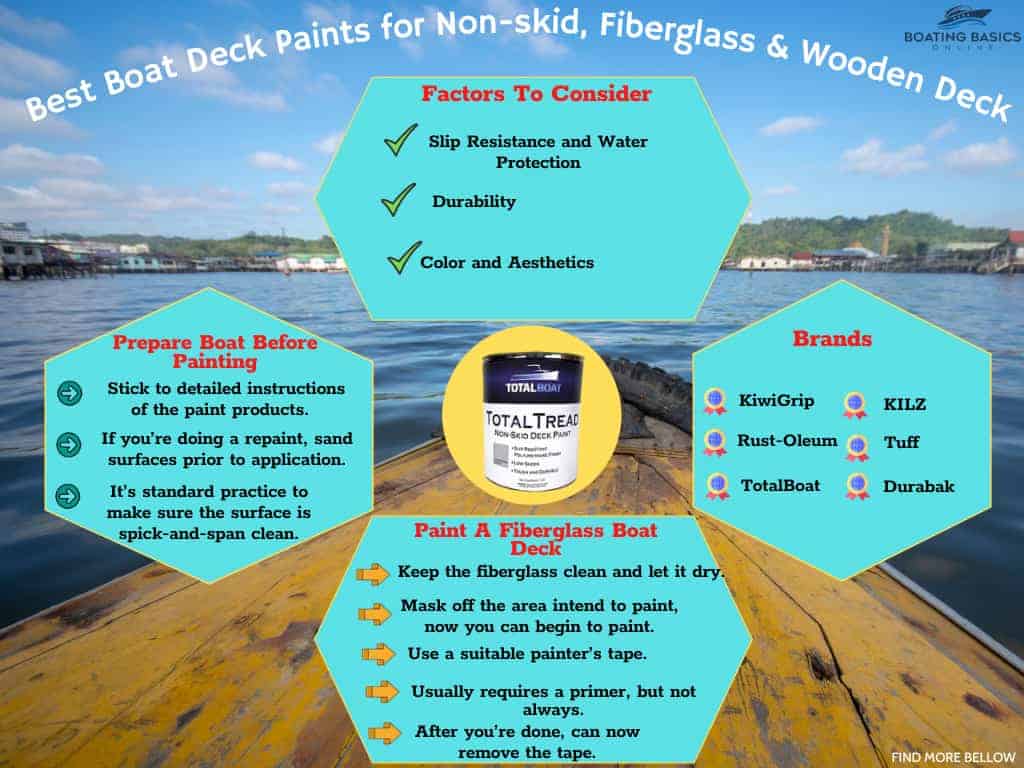
- Decent traction
- Good self-leveling
- Outstanding protection
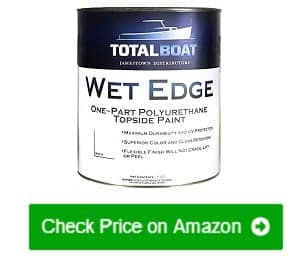
- Very easy to apply
- Decent drying time
- High-gloss and marine-grade
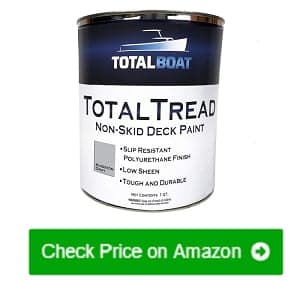
- Notably durable
- Excellent non-skid
- No undesirable odor
Table of Contents
1. Rust-Oleum 206999 Marine Topside Paint
2. totalboat wet edge marine topside paint, 3. totalboat totaltread non-skid deck paint, 4. kiwigrip kg10171r non-skid coating, 5. rust-oleum 207009 marine anti-slip additive, 6. durabak 18 textured non-slip coating, 7. kilz l394811 over armor smooth, 8. liquid rubber smooth polyurethane coating, 9. tuff coat ut-100 non-skid coating, 10. kilz over armor textured, 11. insl-x su031009a-01 sure step coating, 12. evercoat 853 skid-no-more rubberized coating, factors to consider when choosing boat deck paint, what is the best boat deck paint, how should i prepare my boat before painting, how do you paint a fiberglass boat deck, is anti-slip decking paint any good, best boat deck paint reviews.
- Excellent durability
- Strong smell
- Very easy to apply and manage
- Decent drying time and durability
- Doesn’t need a primer if a solid layer of paint is present
- Recommends xylene as thinner
- Limited availability
- Easy to use
- Smoother finish
- Proven durability
- Great traction
- Takes a while to dry
- A little expensive
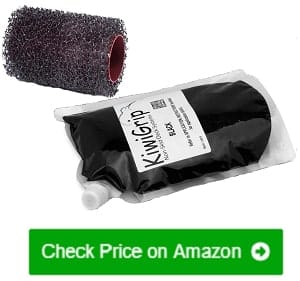
- Comes with a roller for optimal application every time
- Relatively small amount of paint in every container
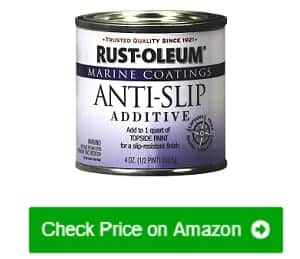
- Excellent slip resistance
- Easy to use with most paints
- Adds an extra layer of protection to boats
- Delivers great results even with minimal amounts
- A bit costly
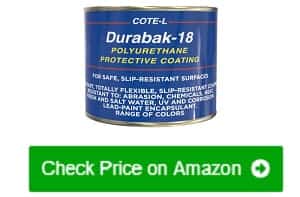
- Delivers way more than what it promises
- Adaptable to most deck surfaces
- Ready to use and easy to apply
- Multiple attractive color options
- Very durable
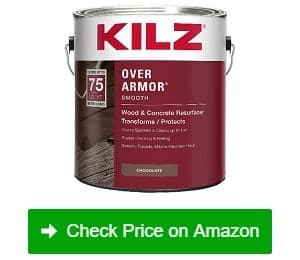
- Budget-friendly
- Attractive finish
- Long-lasting coats
- Superior coverage
- Not that slip-resistant
- Needs to be thinned well
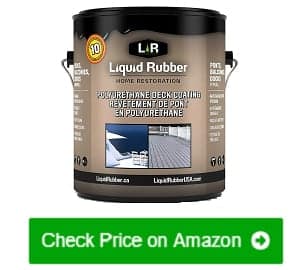
- Comes in many attractive colors
- Above-average durability
- Easy to prep and use
- Well worth the money
- Costs a lot per gallon
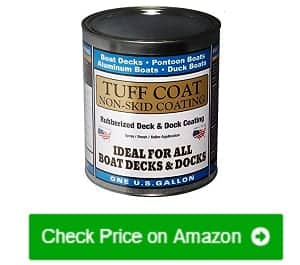
- Superb durability
- Great-looking finish
- Superb color options
- Easy to clean
- Non-hazardous to health and environment
- More expensive than most
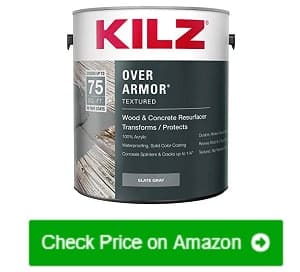
- Excellent traction
- Satisfactory durability
- Feels smooth
- Performs well with one coat
- Quick-drying
- More costly than the Smooth version
- More difficult to apply than other paints
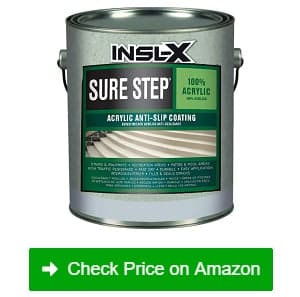
- Excellent coverage
- Amazing traction
- Lasts for a long time
- A bit expensive
- Strong odor
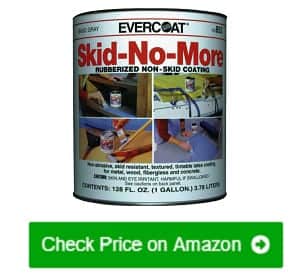
- Versatile on most surfaces
- Strong adhesion
- Great value for money
- Quite difficult to manage
- Unattractive colors
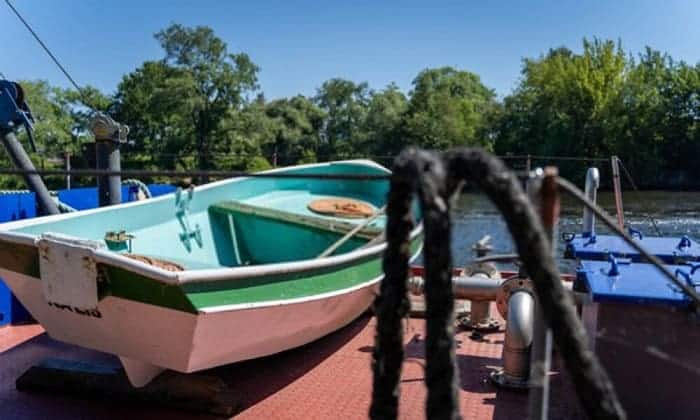
- Slip Resistance and Water Protection
The safest choice is always a paint that offers anti-slip because you need to be confident that you won’t slip or fall regardless of how much your deck gets wet. Not all anti-slip paints and additives are slip-resistant and vice versa. However, getting any of the two would always be a good step in the right direction. Waterproof paint not only tends to stay on longer but is easier to clean, too.
Paints that are UV resistant can resist most weather conditions and can handle the pressure of regular foot traffic and abrasions are what you should aim for if you want coats to last. Epoxy boat floor paint tends to be a safe option for this, but as my list above proves, you should also give other kinds of paint a try, even water-based ones.
- Color and Aesthetics
Your boat’s deck is often the one area of your vessel where you can flaunt your style. The colors you choose can either make or break that factor for you. If you want coatings that can hide the dirt and grime, then I suggest you choose darker ones. As much as possible, don’t let the color for boat decks depart too much from its overall theme.
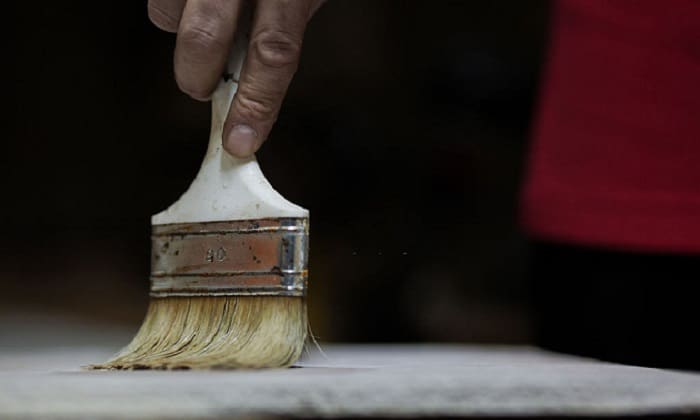
Oftentimes, the paint products themselves would give you detailed instructions about how to prepare your boat to achieve optimal results. In most cases, I’ve discovered that it’s best to stick to these instructions. Otherwise, it’s always best to sand surfaces prior to application, especially if you’re doing a repaint and have to remove flaky stains and coats. It’s standard practice to make sure the surface is spick-and-span clean before you apply any paint product on it.
Besides a few unique steps you need to take, it’s not that much different from painting wood or metal surfaces actually. Make sure you keep the fiberglass clean and dry before applying any kind of paint. Let it dry in a place where it won’t be subject to further moisture or dirt. An important step you shouldn’t forget is to mask off the area you intend to paint. You can use a suitable painter’s tape for this to make sure the final finish won’t have irregular co. Paint for fiberglass boat decks usually requires a primer, but not always. Only use it if the specific paint product calls for it. With the area dried and masked off, you can now begin painting. After you’re done, you can now remove the tape and from there, it’s a waiting game till the coat you applied dries completely.
Yes, there’s no shortage of paints and additives that give the traction you want in your deck surfaces. However, not all of them last long and may need regular application over time. Some are so easy to apply that you won’t mind rolling a fresh layer should the previous coatings begin losing their grip. https://youtu.be/CFi3KRFSw_Y
The best boat deck paint can give you that much-needed Zen-like peace when out boating, fishing, or cruising. Why? Because you won’t have to worry about slips, falls, and a worn-out deck once you apply it. The products I’ve highlighted here can, more or less, help you attain that as long as you pinpoint the best ones for your purposes.

“I am James Harvey – founder of Boating Basics Online. It is established with the drive to help out first-time boaters, which are those desiring to explore their way through the water. So if you are new to boating, start from here with me. “
ACTIVE STORM TRACKER Hurricane and Tropical Storm Information Learn more

Service Locator
- Angler Endorsement
- Boat Towing Coverage
- Mechanical Breakdown
- Insurance Requirements in Mexico
- Agreed Hull Value
- Actual Cash Value
- Liability Only
- Insurance Payment Options
- Claims Information
- Towing Service Agreement
- Membership Plans
- Boat Show Tickets
- BoatUS Boats For Sale
- Membership Payment Options
- Consumer Affairs
- Boat Documentation Requirements
- Installation Instructions
- Shipping & Handling Information
- Contact Boat Lettering
- End User Agreement
- Frequently Asked Questions
- Vessel Documentation
- BoatUS Foundation
- Government Affairs
- Powercruisers
- Buying & Selling Advice
- Maintenance
- Tow Vehicles
- Make & Create
- Makeovers & Refitting
- Accessories
- Electronics
- Skills, Tips, Tools
- Spring Preparation
- Winterization
- Boaters’ Rights
- Environment & Clean Water
- Boat Safety
- Navigational Hazards
- Personal Safety
- Batteries & Onboard Power
- Motors, Engines, Propulsion
- Books & Movies
- Cockpit Confessions
- Communication & Etiquette
- Contests & Sweepstakes
- Colleges & Tech Schools
- Food, Drink, Entertainment
- New To Boating
- Travel & Destinations
- Watersports
- Anchors & Anchoring
- Boat Handling
- ← How-To DIY
Deck Painting Tips
Advertisement
Here are two ways that you can make your deck a lot less slippery — a smart safety idea for all boaters, young and old.
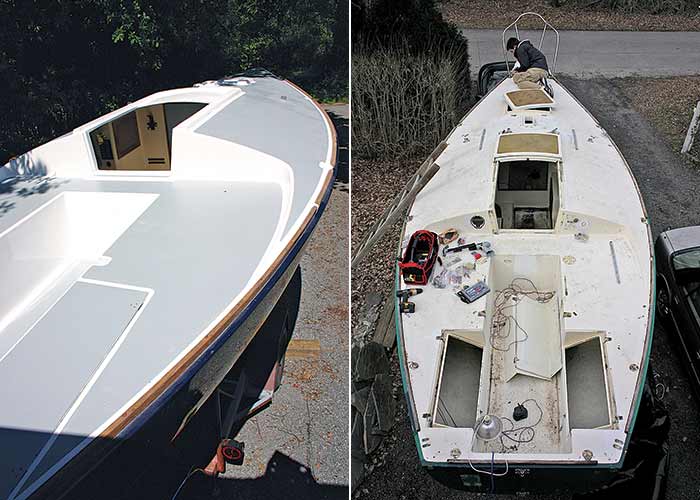
The stripped old-style J/24 deck before we changed and repainted it. The deck (left) shows the final version after repainting.
Fiberglass is slippery when wet. But you know that, you've slipped on the deck of your boat a number of times. You meant to put nonslip tape on the worst spots, but you never got around to it. So what are your options?
Step 1: Buy 3M Slip-Resistant tape and glue it down. The problem with this approach is that the tape only comes in a few colors and stands out on the boat's deck. It will also collect dirt around the edges, and if it's not properly installed, the edges will lift.
Step 2: Use a pre-mixed product such as Interlux's Interdeck or Pettit's EZ-Decks to create a nonslip area. This is fine except that you might not be able to match the color of your deck exactly and may have to recoat the entire deck. In addition, you might need more grip than Interdeck provides. I've found that a deck coated with Intergrip nonslip particles lasts about three to six years (depending on use) before it needs recoating.
Step 3: Take a DIY approach and use a topside paint to match your boat paint exactly and add enough nonslip particles to be sure that you have exactly the right amount of grip without creating sandpaper that will do a job on your knees and behind. I've found that this method lasts longer than Interdeck or EZ-Decks.
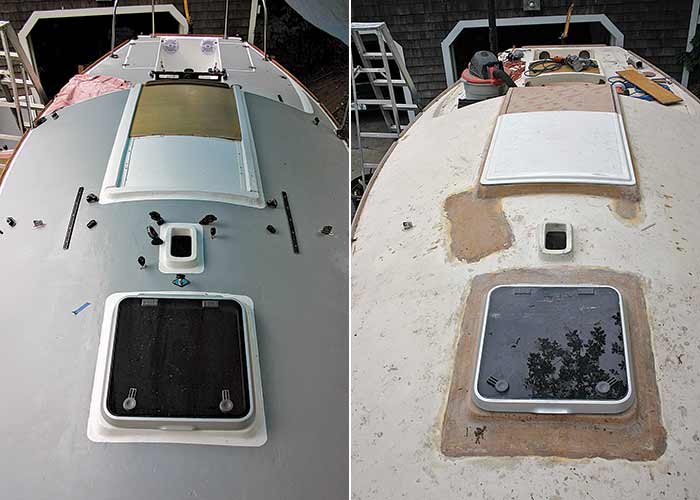
Changes to the deck included fitting a new sliding companionway hatch and sea-hood, a Lewmar forehatch, and repairing rotted balsa core. After repainting, the finished job is shown above right, with some of the deck gear installed.
Painting Interdeck
Painting Interdeck is easy. To get started:
Step 1: Mask off the area to be painted. If desired, you can sand it to give the paint a better grip. Use 220- to 300-grit sandpaper.
Step 2: Wipe down with solvent to remove grease and dirt. For Interdeck, use 2333N solvent.
Step 3: Open the can and mix the paint well. If you wish to make the deck more nonslip, you can sprinkle Interlux's InterGrip onto the wet-paint layer or add it to the can of paint. InterGrip is a polymeric (it contains tiny plastic spheres) nonskid additive available from most chandleries.
Step 4: Roll the paint onto the area to be painted. Use a high-nap roller that can withstand marine paint. If you sprinkle the paint with Intergrip instead of mixing it into the paint, you'll need to cover the area with a second layer of paint.
Step 5: Wait until the paint is almost set up, then peel off the masking tape. Be sure to lift the tape clear of the deck as you peel it; there may be a little wet paint on the tape, and you need to keep it off the deck. Job done!
Step 6: Allow 24 to 48 hours before walking on deck.
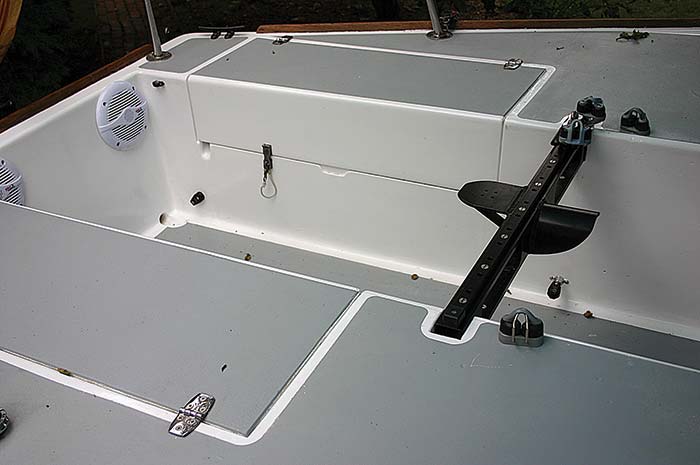
Round all the corners using a small paint can or a coin to ensure that the finished job looks professional.
Get It Right
You can color match and make a longer lasting nonskid surface by doing the job slightly differently.
Step 1: Follow steps 1 and 2 above.
Step 2: Set up your paint. You can use Interlux's Brightside enamel (one-part), Perfection, Awlgrip topside paint (both two-part paints), Pettit's topside Yacht Enamel (one-part) or any of the other topside paints. Mix a flattener into the paint. A flattener will take the gloss off the paint, which is advisable because the sun can reflect off a high-gloss deck and make it difficult to see.
Step 3: Roll the paint onto the deck using a high-nap roller.
Step 4: While the paint is still wet, sprinkle it with Interlux's Intergrip or any other microsphere product. (You can use sand, but it will do what sandpaper does to clothes, knees, and shoes, plus the sand particles will eventually work their way out of the paint layer. You can also use crushed walnut shells, but they add a brownish cast to the paint and can be even harder on you and your clothes than sand.) To sprinkle the powder, make a few 1/8-inch holes in the top of the can with a metal fid or marlinspike. Hold the can about 18 to 30 inches above the surface and sprinkle away. No wind is a must when you do this or you'll find most of the Intergrip alongside the boat.
Step 5: Let the paint and Intergrip dry thoroughly. Now roll on another layer of flattened (non-glossy) paint over the nonskid area. This seals in the microspheres and makes the final layer look nice.
Step 6: Let the paint dry until it is almost set, then carefully peel off the masking tape.
Step 7: Allow 24 to 48 hours for the paint to set up hard before walking on it.
How To Install Nonslip Tape Where You Need It
Nonslip tape is usually installed over slippery areas such as on hatches, where it provides grip without blocking too much light. You can also install it on the edge of stairs, any sloping surface, and other areas where the danger of slipping is present.
Step 1: Make sure the area to be covered is clean. Use a proprietary cleaner recommended by the manufacturer to clean the clear part of any hatches. Don't use acetone, which might discolor hatch glazing.
Step 2: Decide where you want to put the tape. Use a grease pencil to mark off areas. Cut tape to length and use a coin to make quarter-circles at each corner. Trim corners around the quarter-circle to prevent them from lifting later.
Step 3: Peel the backing off the tape and press it onto the area to be covered. Press the tape down firmly (stand on it!) to make sure it adheres properly. That's it, you're finished!
Related Articles
The truth about ceramic coatings for boats.
Our editor investigates the marketing claims of consumer-grade ceramic coatings.
Fine-Tune Your Side Scan Fishfinder
Take your side-scanning fishfinder off auto mode, and you’ll be spotting your prey from afar in no time
DIY Boat Foam Decking
Closed-cell foam flooring helps make boating more comfortable. Here’s how to install it on your vessel
Click to explore related articles
Roger Marshall
Contributor, BoatUS Magazine
Roger Marshall is a writer and yacht designer who lives in Rhode Island.
BoatUS Magazine Is A Benefit Of BoatUS Membership
Membership Benefits Include:
Subscription to the print version of BoatUS Magazine
4% back on purchases from West Marine stores or online at WestMarine.com
Discounts on fuel, transient slips, repairs and more at over 1,200 businesses
Deals on cruises, charters, car rentals, hotel stays and more…
All for only $25/year!
We use cookies to enhance your visit to our website and to improve your experience. By continuing to use our website, you’re agreeing to our cookie policy.

6 Best Boat Deck Paint – (Reviews & Buying Guide 2021)
Ah, imagine if the pirate ships a few centuries ago were able to paint their decks in various colors. Boating wouldn’t have been so gloomy, right? Luckily, today we can put whatever nuance we want on the floor of our boat, but to do so, we need to obtain the best boat deck paint available.
So here, we are giving you this extensive guide on how to purchase the right product but also how to carry out your deck painting project. Before you get to our tips, make sure you check out the reviews of boat deck paint that we have compiled because your project will be doomed without the most suitable paint for your needs.
Best Boat Deck Paint Comparison Chart
| PRODUCT | DETAILS | ||
|---|---|---|---|
TotalBoat Non-Skid Deck Paint | |||
Rust-Oleum Anti-Slip Additive | |||
Liquid Rubber Deck Sealant | |||
Kiwi Grip Non-Skid Deck System | |||
Rubberseal Liquid Rubber Coating | |||
Interlux Slip Resistant Deck Paint |
Best Boat Deck Paints (New List 2021)
So, check out the paints that we have selected, but don’t assume that No. 1 may automatically be the best one.
1. TotalBoat Non-Skid Deck Paint

The finish won’t get scratched or wear away if you scrub it. Apart from applying this product on your boat deck, you can use it for stairs, docks, swim platforms, floors, and everywhere else you need secure foothold.
One galloon will be enough to cover 250 to 300 square feet. Keep in mind that it is advisable to apply two coatings to make the traction more efficient. You can use either a brush or a roller to put this paint on wood, fiberglass, or painted surfaces.
The product comes in four colors, which are suitable for boat decks.
- An advantage of this product is that it withstands not only the weather conditions but also scrubbing and cleaning.
- Since this paint is less abrasive than sand impregnated coatings, it is easier to sweep off.
- This deck paint is easy to apply and adheres well if the surface has been adequately prepared beforehand.
- You can cover around 300 square feet with one galloon, which is more than what similar products offer.
- The time needed for the paint to fully solidify is pretty long. It may take from 2 to 3 weeks, depending on the air humidity.
- As it has an oil base and it is pretty thick, the paint cannot be applied by spray gun unless you thin it.
2. Rust-Oleum Anti-Slip Additive

To understand the effect of this anti-slip better, you can imagine that you add fine white sand to the latex or paint. The texture of this product resembles pumice, which is the reason it makes the surfaces covered with it non-skid. You can be assured that the anti-slip features of this material will be active as long as the coating exists.
If you intend to apply the mixture of paint and this additive on waxed materials, you have to remove the wax first. Make sure that you have prepared the surface well, and it is clean and dry.
- Being mixed with paint or latex, this additive is easy to apply.
- This substance has proved to be durable – its anti-slip effect lasts as long as the coating does.
- The Rust-Oleum additive doesn’t change the color of the paint.
- You can put this product on floors to make sure that they are not slippery because it makes the surface it covers anti-skid
- If you add this additive to top coating, its grains may capture grime, which will make your deck look dirty.
- The surface covered with the mixture of paint and this anti-slip appears to be rough on bare feet.
3. Liquid Rubber Deck Sealant

There is no need to mix the paint with any other substances, and you can apply it by roller, sprayer, or brush. Thanks to its liquid rubber polyurethane formula, this coating makes the surface it covers resistant to water and UV rays.
The area that one gallon can cover is approximately 100 square feet. The manufacturers recommend applying from 2 to 4 coats, especially if the surface is waterproof. Keep in mind that due to the time required for the paint to dry, you cannot apply more than two coats per day.
Depending on how the coating is treated and on the weather conditions, its life expectancy can be from 5 to 10 years. Before applying the sealant, make sure that the surface is clean and dry.
- This product comes in a variety of colors.
- You will be surprised how easy it is to apply this sealant.
- Thanks to the liquid rubber it is made of, this coating bonds very well to the surface.
- Unlike similar products, this one dries quickly.
- You are not advised to apply this paint if the weather is too hot.
4. Kiwi Grip Non-Skid Deck System

The second reason is that it is very convenient to apply this coating using the KiwiGrip roller. Not only will you cover the surface with this tool with only one coat, but there won’t be any need for additional fillers. What is more, there won’t be any traces of shells, rubber particles, or sand on the covered surface.
The third reason which makes this product worthy is the fact that it is eco-friendly because it is water-based. This coating comes in 5 colors you can choose from.
- The product comes with a KiwiGrip 4-inch roller.
- You can save money using this material, as you will need only one coat of it.
- Its water base makes the Kiwi Grip eco-friendly.
- This substance makes the surface it covers anti-skid.
- As the KiwiGrip is not a sealed paint, you will have to prime any aluminum surface before you put the coating.
- If you want to have the non-skid effect that this product offers, you have to apply it only using the KiwiGri roller, which is a limitation as some people may prefer brushes or sprayers.
5. Rubberseal Liquid Rubber Coating

here are four colors you can choose from. If you need another color which is not offered, you can use elastomeric paint. Keep in mind that it is advisable to apply two coats of the rubber seal. Make sure that the surface is clean of dirt or residue and dry before you put the coating.
An advantage of this product is that it features elongation, which means that it will expand and contract with the expansion and contraction of the material it covers. Even though this coating has a slight odor, it is not unbearable. Since this rubber seal is water-based, it won’t bond to wood or any oil-based surfaces.
- This product has an EPA star rate, and it is resistant to UV exposure.
- You can easily apply the coating by roller, brush, or sprayer.
- Being pretty thick, this material adheres well to the surface and protects it from water.
- The manufacturer offers four colors of this coating.
- It takes around five days for the coat to be ready, and you need to make sure the weather is hot during this period.
6. Interlux Slip Resistant Deck Paint

Bear in mind that it is recommended to apply two coats of the paint for better results. Interlux is one of the manufacturers who offer very handy to use non-skid paints. The easiest way to do it is by roller. A disadvantage of this product is that the lighter colors get dirty quickly, and the dirt is hard to come out. This effect is caused by the small grains that the paint consists of, which gather grime.
- This Interlux paint is easy to apply and provides a good grip.
- You can walk safely on a floor covered with this material as it is non-slippery, but at the same time, it is not rough on your bare feet.
- Interlux offers four colors you can choose from.
- The paint doesn’t reflect the sunlight glare.
- The white paint gets dirty quickly because of the little grains that gather the dirt.
Importance of Having a Non-Skid Boat Deck

So how do we achieve that effect, and can it be a DIY project? It absolutely can be, and there are two main ways to have a non-skid deck.
- Use a can of designated non-skid paint
- Mix a non-skid additive with your color.
The latter will require you to purchase two materials while the former will allow you to deal with the whole project just by using a can of paint. Both options are worth exploring because we simply have to be aware of all the benefits of non-skid deck applications .
When we talk about the boat deck, the surface you are painting will likely be wood or fiberglass. Some people also go for rubber boat flooring.
The hull of the boat may be made of aluminum but definitely not the deck. Still, the body will also require painting, so you might as well jump to our reviews of the top paints for aluminum boats and see if you like our picks.
How to Paint my Fiberglass Boat Deck?

- Select the right paint
This is why we have compiled the reviews and the top list above. We suggest you pick one of the selections and go with it. If you go with a topcoat paint, you will also need to get an additive. The two-part polyurethane products eliminate the need to do so.
We will follow the steps of painting a deck using either of the options. Only towards the end, the stages differ from one another. There is also a third option which we will not outline – purchasing a paint which has been pre-mixed with some powders. We don’t have such a product on our list because we don’t think the quality is exceptional.
- Preparation
This is an essential part of your project. Ys, many people suggest that the actual application of the paint matters because inexperienced people can make it look ugly. While this is correct, experienced pros will also achieve poor results if they work on a poorly prepared surfaced.
Do you know what Marcus Aurelius said? The secret to all victory lies in the organization of the non-obvious. This is why we will devote a little bit more time to this stage of the project and will list some of the things you have to pay attention to.
- Start by deciding where you will conduct the whole paint job. We don’t suggest you do it outside. It is best if the boat can be indoors and even out of the water. Some vessels can have the panels of the deck removed. This will allow you to paint piece by piece and then have them installed back. In any way, find a shelter that is large enough and has sufficient amounts of airflow.
- Don’t paint early in the morning or late in the evening. We recommend you do that before noon because this is the optimal time for any paint to cure. During the evening, the moisture levels will rise and will slow down the process of drying.
- We at The Marine Mag know how to take care of a boat. Check out our boat detailing page for more info. Until then, remember that if you prepare things correctly, you will have less work after you finish painting. Masking is an integral part of the procedure, and you must be very careful with it. Make sure you do not leave any air under the tape and also be careful to create straight lines. We suggest not to don’t rush it.
- Become familiar with the instructions. Diluting your paint or not using the correct amount can result in disastrous outcomes. Don’t underestimate the information on the can. After all, the manufacturer will know best exactly how to mix the paint. They’ve conducted the tests for you.
We got a couple of tips related to sanding as well. This is also a crucial stage because if not done correctly, you will notice that the paint may look different in some areas. The good thing is that once you paint using a non-skid paint, you won’t need to sand for any subsequent paint project on that surface.
But if that’s the first time you are painting the deck, then roll back your sleeves and get to work. We recommend using an automatic sander. The ones that rotate in random directions are the best. No need to push hard – let the machine do the work. You can also use a palm sander, but such an item will be good for the edges or some hard-to-reach spots.
This is another tool on which you don’t want to go cheap. Use it generously because once the sander wears off, it’s really no good. Applying a new brand-new sander is always very useful, so once you feel like the paper is thinning, change it.
- Clean before you paint
After all the sanding and masking, you will surely see plenty of dust on the deck. Never neglect cleaning the area before you whip out the can of paint. Make sure you sweep or vacuum every little piece of dust because the filthy surface is impossible to paint, and your project will be a grandiose failure.
This is where we suggest you check out our pro reviews of the top boat cleaning brushes . You cannot own a boat without having a brush around. See the most popular products and pick one.
Applying the Paint on the Deck
And now we get to the meat of things. This is where the situation changes a little bit because you may have opted for a paint that has its own non-skid properties. Your other options are the classic one, where you will have to mix the paint with an additive. So let’s begin with that choice and outline the process of using a powder.
Using a non-skid additive with your boat deck paint
The exciting thing here is that this subsection is divided into even more possible choices and steps. They are all related to how you want to have the paint, and the additive mixed. You got three main choices.
- Paint the surface using your regular coat and then use a strainer to distribute the powder on the surface. You will have to wait for the paint to cure a little bit and then blow the powder that hasn’t stuck away. Then, apply the second coat and seal the powder between the two layers of paint.
- Your second option is to simply use your hand and spread the additive over the paint. This is similar to what you do when you season your food. You just have to be careful to distribute the material evenly.
- The trickiest option is to mix the additive and the paint before application. This will yield the best results, but it can also turn into a catastrophe. You must be sure you are aware of the proportions because otherwise you risk using too much or too little powder. In the first case, applying the mixture will be a nightmare as your roller or brush will likely get clogged with the additive. In the second case, you will barely achieve any non-skid effect.
Using a two-part paint where extra material is not required
Some paints (even on our list) do not require the use of powder to create non-skid substance. This is quite the advantage, and the whole project may turn out to be a simpler one.
- Use a brush and start applying the paint at a shallow angle. Put down as thick of a layer of paint as possible.
- This paint should come with a unique roller with an advanced grip. This is not your typical foam roller but a curly one, which is used only to create the texture. It is essential to remember that part. You don’t use the roller to distribute pain but only to texturize it. Go over the surface a few times and in different directions so that you can achieve a uniformed pattern.
- Wait for it to cure and remove the tape. You’re done!
This is where we will say “goodbye” only to hope to see you again in one of our other guides. The Marine Mag team is sure to have helped you in your search for the best boat deck paint . If you have any doubts regarding a specific product, by all means, read or reviews of boat deck paint once more.
Tell your friends and family about us and leave us a comment. Your feedback is much appreciated, and it makes us always move in the right direction. Thanks for reading!
Leave a Comment Cancel reply
Save my name, email, and website in this browser for the next time I comment.
Better Sailing
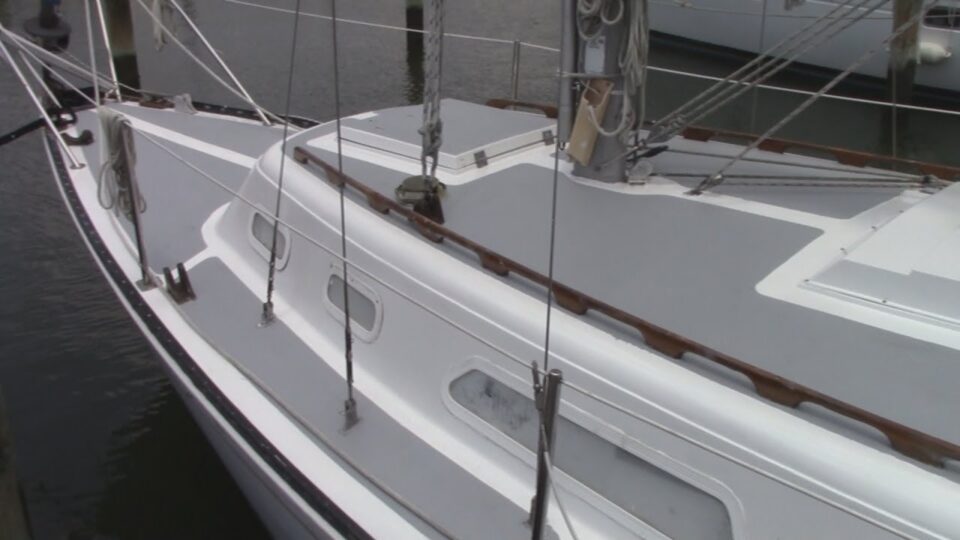
Best Non Skid Boat Deck Paints
Painting your boat’s deck can be a challenging task. In this article, we will take a look at the Best Non-Skid Deck Paint for your boat or sailboat. For this article, I asked some boaters friends of mine, marine product professionals, and some online forum buddies of mine and well as my personal experiences with some of the following products.
A good non-skid boat deck paint provides a slip-resistant surface on your boat that is essential when you try to move on your deck even at the best of conditions. In foul weather, a non-skid coat of paint could be the difference between life and death. These anti-slip paints will increase friction and reduce the likelihood of a fall overboard.
Kiwi Grip Non-Skid Deck Paint – Overall The Best Non-Skid Boat Deck Paint
If you’re DIYing it. Go with Kiwi Grip . It’s overall the best non-skid deck paint for your boat, and as long as you plan well, you can do a whole boat, including the cockpit, in about three sessions. But be warned, it’s expensive stuff. It costs around 150$ per gallon (4 Liters), and each gallon can of KiwiGrip can cover about 80 square feet.
I like the Kiwi Grip because it’s water-based, so easy to clean up and deal with. For the non-skid effect, you just use a special roller, no sand or crushed shell or whatever people add for the non-skid effect, which makes for an easy application. It probably the easiest material to work with to give your boat the desired non-skid effect.
It is a good idea to experiment on a piece of plywood before tackling your deck. Kiwi Grip is easy to mess up like just about anything! Practice makes almost perfect! But do not worry, even a bad Kiwi Grip job still works great; making it look pretty is about finesse and practice. A Blue Paper Masking Tape will be your best friend in this application, so you can make the edges perfect.
I had very good results with Kiwi Grip; follow directions carefully, don’t let it freeze, and practice, for the best possible results, apply the paint on a dry and hot day. Remember, you can always go over any part that isn’t perfect again. And last but not least, do not forget to wear a mask.

- Easy To Apply
- Great Non-Skid Effect
- Doesn’t look as good as some other options if not done carefully
TUFF Coat Non-Skid Coating
This type of paint is becoming very popular lately, and for a good reason, TUFF Coat is easy on your feet, highly durable, and has the added benefit of looking good as well. A friend of mine has used it for about 10 years now on his catamaran sailboat. He recoated once, 4 years ago, and is very happy with it. The two-part primer they have for it is very runny, so be careful with it. It sticks to itself great, though. It stretches a bit, which can hide minor Gelcoat cracking, and is very soft on the knees and bare feet because of the rubber particles.
For proper application, use a drill mixer to thoroughly stir and suspend all the rubber non-skid particles into the paint. Then, pour the coating into a paint tray and load your roller with enough paint. For maximum non-skid effect, you can use a paint roll similar to the one that is used for the Kiwi Grip application. That way, you will get the benefits of both the texture and the non-skid particles.
You will need around 1 Gallon of this stuff to cover 150 square feet of deck surface; per coat, 2 necessary, 3 recommended.

- Easy to apply
- Many colors
TotalBoat TotalTread Non-Skid Deck Paint
This is another single part nonskid paint for your deck, so you do not need to mix anything yourself. Just remember to stir very thoroughly before applying to ensure the solvents and non-skid particles are mixed in evenly, preferably with a paint mixer . This paint gives a flat finish with a non-slip texture, so if you do not like the texture that Kiwi Grip has, this is probably the way to go. It comes in 3 colors white, gray, and sand beige. To get a good result, you will need about two coats of paint, but if you decide that the desired effect is not there yet, you can add an extra coat for a more slip-resistant surface.
Before applying, make sure you clean the fiberglass properly with plenty of water and soap (let it dry) or prime first with TotalBoat Topside Primer. You can use both a brush or roller, but I would recommend rollers to get a more even result.
This product is very user friendly since the application is as straight forward as painting a wall at your home. As a pro tip, it is better to apply multiple thinner coats of paint instead of one or two thicker ones. Also, give the paint one or two days to dry before you apply another coat, depending on temperature and humidity.
Keep in mind that you will need around 1 Gallon of this stuff to cover 250 square feet of deck surface.
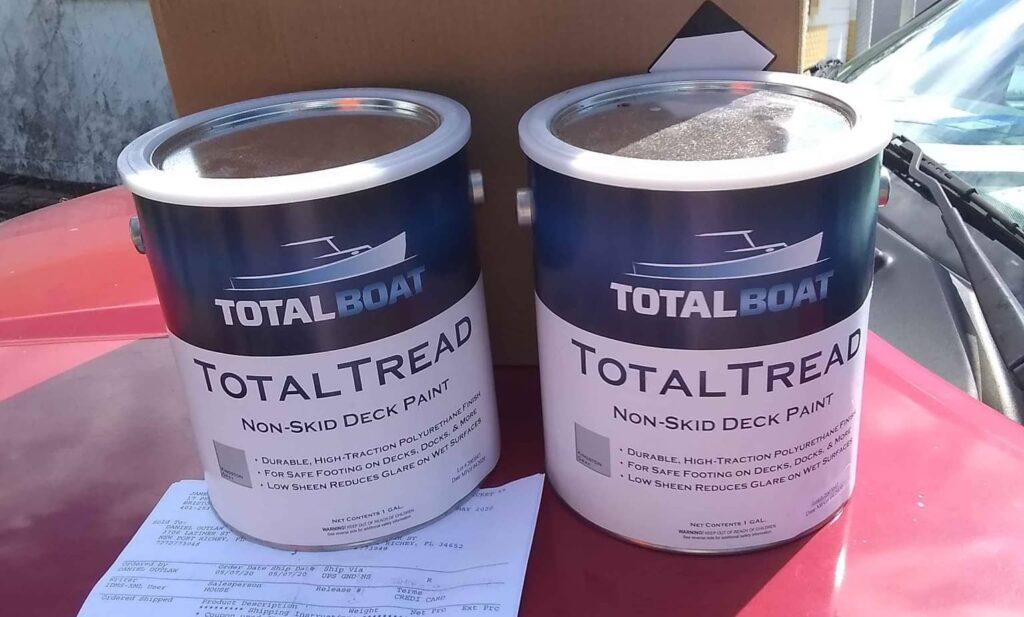
- Not very durable
- Doesn’t dry easily in humid and colder climates
Interlux Interdeck Slip Resistant Deck Paint
This is a one-part polyurethane paint with the non-skid particles already mixed in; just remember to shake the solution well before applying to make sure all the solvents and non-skid particles are mixed in evenly. Also, while you are applying the paint, keep stirring it often because the non-skid will settle down to the bottom of the container. Interdeck has a nice matt finish to reduce sun glare. It may be applied over any type of paint, but you should not apply it over clear epoxy. Clear epoxies must be primed with Epoxy Primekote 404/414 before applying. Make sure to go through and follow directions carefully to make sure you properly prepare and apply the paint. Also, make sure to put tape over the areas you do not want to apply the non-skid paint to get the best looking deck.

Awlgrip TopCoat With Griptex Non-Skid Additive
This what the professionals recommend when it comes to non-skid deck paints. However, you will have to use Awlgrip TopCoat and also use their Griptex additive. You mix the two products together, preferably with an Electric Paint Mixer , and then the solution can be rolled on.
My boat had previously painted with Awlgrip TopCoat With Griptex Non-Skid Additive. The boatyard this winter sanded it, primed, applied two coats of paint with rollers, then they sprinkled the Griptex with a salt shaker-type when the paint was still wet, vacuumed the loose Griptex particles off, and then rolled on two more Awlgrip TopCoat coats on. I found it smart and intuitive instead of mixing more material than you need and wasting it. Awlgrip with Griptex additive will look the best, but its grip is inferior to Kiwi Grip.
AwlGrip White Base With Crusted Walnut Shells
I have to say this is a very controversial way to apply a non-skid coat on your boat. However, a friend of mine has done it, and I have been on this boat, and I must say that the result is great. It feels good on your feet, it has the desirable non-skid effect and is also pretty affordable.
You apply it the same way you would apply the Griptex Non-Skid Additive to your AwlGrip TopCoat. The best way to apply it is to coat a thick layer of AwlGrip on your deck and then sprinkle the Crusted Walnut Shells on the wet paint; make sure to sprinkle the shells evenly. Let it rest overnight, and then vacuum the loose Crusted Walnut Shells off. Then, apply two more coats of Awlgrip TopCoat.
>>Also Read: Best Boat Coatings
Tips For Appling Any Non-Skid Paint On Your Boat
There are two types of people when it comes to preparing your deck for paint application. Many people sand their whole deck, and then they vacuum and clean it. The other ones just use a good deck cleaner and plenty of water to thoroughly degrease and clean the deck. That second way is ok if it is the first time you are applying a non-skid paint on your deck. However, you must remove all chips and peels from the deck’s surface. If you are reapplying, I would recommend removing the old coat first or at least sanding the old coat off as much as possible.
Pick a day that is not overly hot and sunny nor cold and cloudy. You do not want your paint to dry up too quickly nor to stay wet for two days straight. However, make sure to leave the paint cure at least for hours before you apply another coat.
Use a paint mixer drill attachment to stir the paint before each application, especially on two-part non-skid paints. I would recommend this on pretty much all the paints featured in this article, but you can get away without using one on the Kiwi Grip because there are no non-skid particles suspended on that type of paint.
Lastly, you will need a paint set that includes paint rollers, paintbrushes, and a paint tray. Also, get a Blue Paper Masking Tape to help you protect the non-skid areas and help achieve the best possible look.
Final Thoughts
The Best Non-Skid Boat Deck Paints is the Kiwi Grip, hands down; it is easy to apply and will get you the best result. To spruce up your boat’s deck with great functionality, you need to apply a new coat of non-skid paint. You’ll be able to change the color (Kiwi Grip comes in Black, Blue, Cream, Grand, and White) and dress it up while also adding a layer of protection to your deck’s surface. Old, dull fiberglass surfaces like your deck can become fresh and clean in very little time and effort. The Best Non-Skid Boat Deck Paint will also protect fiberglass surfaces from liquids, repel stains, and provide a nonslip surface for safe walking. Also, if your fiberglass has developed chips and spider cracks over the years, a coat of paint will cover them right up and your boat will appear as good as new.
Also, if you are not sure you want to paint your deck them you could consider a Non-Skid Self-Adhesive Foam Teak Marine carper for your boat.
Peter is the editor of Better Sailing. He has sailed for countless hours and has maintained his own boats and sailboats for years. After years of trial and error, he decided to start this website to share the knowledge.
Related Posts

The Ultimate Guide to Choosing the Best Fishing Line for Trolling

Lagoon Catamaran Review: Are Lagoon Catamarans Good?

Best Inboard Boat Engine Brands

Are O’Day Sailboats Good? A Closer Look at a Classic Brand
- Buyer's Guide
- Destinations
- Maintenance
- Sailing Info
Hit enter to search or ESC to close.
- International Marine Coatings
- International Protective Coatings
How do you paint non-skid decks?
Although there is no single, universally proven deck surface that will prevent people from slipping on a boat deck, a low-cost, slip resistant finish gives added protection and can be easily applied. Find out how below.
Interlux now offers three solutions for refinishing a non-skid deck:
- Stir and apply Interdeck – a pre-mixed, slip resistant, single component, ready to use deck paint that can be applied over Prekote primer or Epoxy Primekote primer 404/414.
- Mix your own non-skid finish: any one of the Perfection or Brightside Polyurethane finishes can be transformed into a non-skid deck finish by the addition of Intergrip Polymeric non-skid compound 2398. Intergrip is made from small plastic spheres that have regular shape, low tendency to collect dirt and excellent non-slip properties. Once Intergrip has been added to paint general application directions are followed, except there is no need to sand between coats. Our two part polyurethane, Perfection, provides the most durable and long lasting finish for decks.
- Hand Broad casting method - while the first of paint is still wet, sprinkle the Intergrip as required to obtain the texture of your choice. It is best to put the Intergrip in a flour sifter or salt shaker to dispense the compound. Avoid heavy application which will not assist in providing a more slip resistant surface. After the paint has been allowed to dry overnight remove the excess Intergrip and apply the second coat of paint.
Paint your boat like a pro
Find the best products to keep your boat in great condition
Get all the support you need to paint with confidence
Benefit from our continuous innovation and scientific expertise
Select your country
Our products and guidelines are customised for each country. Please select yours below.

- Canada Canada
- United States United States

Asia Pacific
- Australia Australia
- New Zealand New Zealand
- Singapore Singapore

- België Belgium
- Hrvatska Croatia
- Danmark Denmark
- Suomi Finland
- France France
- Deutschland Germany
- Ελλάδα Greece
- Ireland Ireland
- Italia Italy
- Nederland Netherlands
- Norge Norway
- Portugal Portugal
- España Spain
- Sverige Sweden
- United Kingdom United Kingdom

Middle East & Africa
- South Africa South Africa
- Türkiye Turkey
Who's painting?
Choose one of the following to tailor the site to your needs.
- International Marine Coatings
- International Protective Coatings
How do I paint a non-skid deck?
Although there is no single, universally proven deck surface that will prevent people from slipping on a boat deck, a low-cost, slip resistant finish gives added protection and can be easily applied. Find out how below.
First, choose the right paint.
A deck demands a tough coating to protect it from the damaging effects of foot traffic, anchors and other gear that may fall on it. With that in mind, a two part polyurethane paint with a non-skid additive / powder is possibly your best option. You aren’t limited to using a two-part paint though, you can also add such additives to single pack top coat paints. Alternatively, you can use products that are premixed with suitable non-skid aggregates.
How to apply the non-skid additive / powder material
There are various ways of applying the material and it really comes down to how you’d like to tackle the job. Below are our suggestions, but you may have other ideas and it really doesn’t matter as long as you achieve the effect you want.
- The easiest way is to shake the powder onto a layer of wet paint. One way to do this is to take a plastic container and drill many 3 mm holes in the lid and use the container like a large pepper shaker. Shake the powder on until the whole surface is covered by a layer of powder. Allow the paint to semi-cure and then blow the excess powder off the surface and apply a further coat of paint to seal it all down.
- Another way is to stir the powder into the paint and then apply. This method can be a little tricky, as you have to ensure the powder doesn’t bunch up under the roller or brush giving a patchy effect.
- The other method is to hand broadcast the powder on to the surface as if you are sowing grass.
How to produce the non-skid area
- Firstly, make sure the second coat of the topcoat you applied is well cured and that you follow the drying and overcoating times on the topcoat label.
- Mask-off the area in the pattern intended for non-skid. You can use 3M® 218 Fine Line masking tape which goes around curves really well. Or you can use normal masking tape laid down in strips at the corners and then carefully cut it into a curve. Cans and jars of various sizes are useful as templates to create exactly the curve you want.
- Paper mask-off the area you want to protect.
- Lightly roughen the exposed areas with 280 grade paper.
- Apply one coat of topcoat as per label instructions.
- Using one of the methods described above, apply the powder material while the topcoat is still very wet.
- Allow the coat of paint to dry for the appropriate period. Do not exceed the overcoating time.
- Very carefully vacuum or blow away any excess powder.
- Carefully apply a second coat of topcoat taking care to do it without over brushing.
- Allow to dry for a few days before allowing heavy traffic use.
Refurbishing an existing deck
This can be difficult to do, however the easiest way is to sand the existing system back to a smooth finish and re-apply undercoat / topcoat / additive powder. Attempting to clean and prepare the existing surface and then apply new coats of paint may result in the original non-skid finish being partially buried. This could cause adhesion problems with the new system if it’s not prepared properly.
Paint your boat like a pro
Find the best products to keep your boat in great condition
Get all the support you need to paint with confidence
Benefit from our continuous innovation and scientific expertise
Select your country
Our products and guidelines are customised for each country. Please select yours below.

- Canada Canada
- United States United States

Asia Pacific
- Australia Australia
- New Zealand New Zealand
- Singapore Singapore

- België Belgium
- Hrvatska Croatia
- Danmark Denmark
- Suomi Finland
- France France
- Deutschland Germany
- Ελλάδα Greece
- Ireland Ireland
- Italia Italy
- Nederland Netherlands
- Norge Norway
- Portugal Portugal
- España Spain
- Sverige Sweden
- United Kingdom United Kingdom

Middle East & Africa
- South Africa South Africa
- Türkiye Turkey
Who's painting?
Choose one of the following to tailor the site to your needs.
- New Sailboats
- Sailboats 21-30ft
- Sailboats 31-35ft
- Sailboats 36-40ft
- Sailboats Over 40ft
- Sailboats Under 21feet
- used_sailboats
- Apps and Computer Programs
- Communications
- Fishfinders
- Handheld Electronics
- Plotters MFDS Rradar
- Wind, Speed & Depth Instruments
- Anchoring Mooring
- Running Rigging
- Sails Canvas
- Standing Rigging
- Diesel Engines
- Off Grid Energy
- Cleaning Waxing
- DIY Projects
- Repair, Tools & Materials
- Spare Parts
- Tools & Gadgets
- Cabin Comfort
- Ventilation
- Footwear Apparel
- Foul Weather Gear
- Mailport & PS Advisor
- Inside Practical Sailor Blog
- Activate My Web Access
- Reset Password
- Customer Service

- Free Newsletter

Blue Jacket 40 Used Boat Review

Catalina 270 vs. The Beneteau First 265 Used Boat Match-Up

Ericson 41 Used Boat Review

Mason 33 Used Boat Review

How to Create a Bullet-Proof VHF/SSB Backup

Tips From A First “Sail” on the ICW

Tillerpilot Tips and Safety Cautions

Best Crimpers and Strippers for Fixing Marine Electrical Connectors

Polyester vs. Nylon Rode

Getting the Most Out of Older Sails

How (Not) to Tie Your Boat to a Dock

Stopping Mainsheet Twist

Fuel Lift Pump: Easy DIY Diesel Fuel System Diagnostic and Repair

Ensuring Safe Shorepower

Sinking? Check Your Stuffing Box

What Do You Do With Old Fiberglass Boats?

Boat Repairs for the Technically Illiterate

Boat Maintenance for the Technically Illiterate

Whats the Best Way to Restore Clear Plastic Windows?

Stopping Holding-tank Odors

Giving Bugs the Big Goodbye

Galley Gadgets for the Cruising Sailor

The Rain Catcher’s Guide

Sailing Gear for Kids

What’s the Best Sunscreen?

UV Clothing: Is It Worth the Hype?

Preparing Yourself for Solo Sailing

R. Tucker Thompson Tall Ship Youth Voyage

On Watch: This 60-Year-Old Hinckley Pilot 35 is Also a Working…

On Watch: America’s Cup

On Watch: All Eyes on Europe Sail Racing

Dear Readers
- Inside Practical Sailor
Refinishing Your Boat’s Non-skid Deck
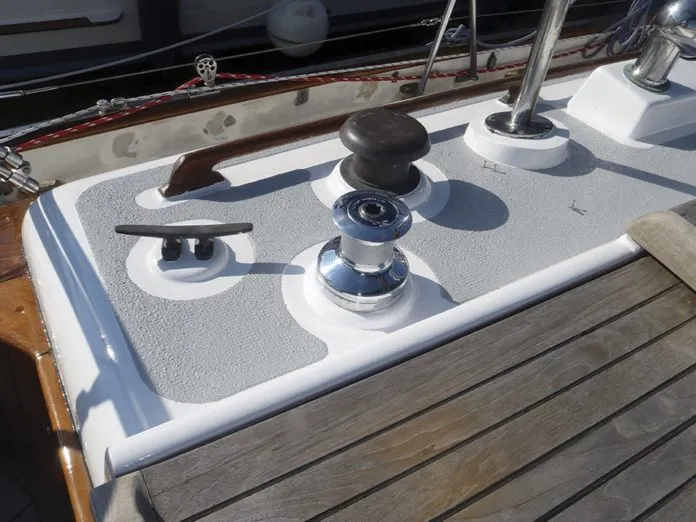
While the consequence of letting your varnish and hull paint to fade is usually no worse than a blow to your ego, you don’t want to let your non-skid deck paint lose its grip. More than a few cruises have been cut short because someone lost their footing on a slippery deck.
Refinishing your boat decks nonskid coating is a big project, but so are the payoffs. Not only does it make your deck look like new, it is a whole lot safer. Here some general tips to help you get more mileage out of a nonskid restoration. For additional research, I’ve posted links to our previous tests of non-skid deck products.
Proper Application
The secret to durable non-skid starts with proper application.
Surface prep: We all know proper surface prep can make or break coatings applications, but it also directly affects the coatings service life. Always follow makers recommendations.
To prime or not to prime? That depends on the deck substrate being painted and the type of paint being used. If the surface is bare wood or bare metal, plan to apply a coat of primer (and a sealer for wood). A one-part primer is often sufficient, but a two-part epoxy primer will offer more durability and hardness. If you are allergic to epoxy, there are some excellent polyurethane primers designed for cars that also have good track records in the marine environment ( PS is currently researching this further and would be interested in hearing from readers who have gone this route). Bare fiberglass requires a dewaxer, scuff sanding, and a coat of primer when applying most paints; however, some paints like Durabak and KiwiGrip recommend primers only for bare metal and wood.
Application: The surface must be clean and totally dry. After sanding, wipe it down with xylene, dewaxer, or acetone. Some paint makers warn against using solvents, so be sure whatever you wipe down with is compatible with the paint. The easiest paints to apply are those one-part paints that have the additive already mixed in. As long as the paint is thoroughly mixed, you can achieve a relatively even finish (see the cardboard trick described below for two-part paints).
When it comes to using a paint with a separate nonskid additive, we recommend combining the mix-in and broadcast methods to get the most uniform grit pattern. Mix the nonskid additive with the paint, roll it on with the recommended nap roller (usually 1/4″ – 3/8″ solvent resistant), and sift more aggregate on the paint while its tacky; once the paint dries, you can brush off the excess and apply a second coat in the same manner. You can make an aggregate shaker by poking a dozen or so holes in the lid of the can with an ice pick, then up-ending it to sprinkle the additive across the deck. Pre-mixed nonskid paint users can also broadcast nonskid additive atop coats of the pre-mixed paint for a more aggressive grip.
Two-part LPU paints like Awlgrip will generally last longer and stay cleaner than textured paints or one-part coatings, but these temperature and humidity-sensitive products can be more difficult to apply for a first-timer. If you are rolling, the makers generally recommend that the additive be sprinkled or sprayed on while the paint is still tacky to achieve an even covering. The excess additive is brushed and vacuumed away and then the surface is recoated with paint (no additive). Following the maker’s guidelines for spray application will generally achieve a more even result.
Although the maker of Awlgrip advises that Griptex, the designated texture additive, should not be mixed into paint when rolling paint, we have done this using a technique shared with us by a Florida boatbuilder who has used this on his own boats for years. If you want to go this route, you should do a few test runs.
The main problem with using a roller to apply LPU paint with the non-skid additive mixed is that the texture tends to clump. This problem is exacerbated by the narrow working window for applying with two-part paints. To avoid clumping and wasting paint, you can use a small sausage roller with a medium to fine fiber nap (3/8″-1/8″). Be sure the roller is solvent resistant. Foam roller covers are not recommended. Carefully measure the desired texture before adding it to the pre-mixed paint, and thoroughly stir the additive into the pre-mixed paint. Before painting, roll the roller across a sheet of cardboard to ensure the paint is evenly distributed across the roller.
To reduce paint waste, we used lint-free 1/8″ solvent-resistant mohair sausage roller covers used for working with marine paints and resins. You can use up to 3/8″ inch roller covers using this technique—but test first. These mohair rollers are lint-free, but to ensure there was no lint, we rolled them over the sticky side of our masking tape to remove an loose fibers.
Work in small section and change rollers frequently. We used a 50/50 mixture of fine and medium grit additive in our Awlgrip. We did not do this with coarse grit, which we assume, would produce more obvious clumping if the paint is not throughly mixed.
A final coat, without grit, sealed the surface. Be sure to keep the coats thin-multiple thin coats are preferred over one heavy coat-and plan to apply the paint when there is minimal humidity. On all but a few tiny sections, the result was an even non-skid that was indistinguishable from a spray-on coating. When we recoat, we will likely do the broadcast method recommended by the manufacturers to see how it compares.
If are looking at ways to prevent slipping on step pads, stairs, or work stations (at the base of the mast, for example) and are not yet ready to embark on a paint project, check out our report on report on non-skid tape .
Taping: Use only high quality masking tape designed for outdoor use. Do not exceed the manufacturer’s recommended service period, otherwise you’re in for a big job removing tape one fleck at a time. Ralph Naranjo evaluated all the leading tapes from the leading manufacturer 3M in his report 3M Masking Tape Matchup . He also included techniques on following tight curves, which are common on non-skid sections.
Curing: Follow the makers recommendation for dry time, and be sure to allow the paint to fully cure before subjecting it to foot traffic. This allows the paint to achieve maximum hardness, making it more abrasion resistant and longer lasting.
Mat Installation: If you’re installing a self-adhesive mat, application is a no-brainer. Just be sure its where you want it before you stick it to the deck; contact adhesives don’t allow the small wiggle adjustments that epoxies do in application.
Testers also learned a few application lessons the hard way when installing nonskid mats with two-part epoxy. The epoxy usually has about an hour of pot life before it becomes permanently stuck to whatever its touching, so clean up any errant epoxy with a solvent as soon as possible.
Its also best to decide on the mats exact location before mixing the epoxy; you can use paper templates to help in this process. Be sure to leave a lip around the mat edge that is free of glue; the epoxy will squeeze into the bare area when the mat is put in place.

Regular Maintenance
Boat bath: Nonskid paints and mats should be cleaned regularly to remove abrasive salt spray and dirt. Wash with standard, mild boat soaps ( PS, January 2013 ) or household cleaners and a soft- to medium-bristled brush. Steer clear of bleach and other chlorinated or acid-based cleaners as they can affect the paints color pigments and UV inhibitors. Be sure to rinse the decks well with fresh water, when possible.
Mold and Mildew: To prevent mold and mildew, you can lightly scrub the surface with an ammonia/detergent solution. To spot clean areas that are heavily soiled or show mildew, you’ll likely need to step up to more aggressive cleaner. Pettit recommends its Bio-Blue 92; the blend of cleaning agents and silica grit also can be used to de-wax or etch during surface prep. Durabak recommends fighting mildew and stains with a disinfectant like Lysol, and KiwiGrip advises using bleach or a mild acid solution to remove mold and mildew stains.
Wax Not: While waxing can breathe new life into topside paint, the paint makers we talked to do not recommend waxing painted nonskid. Most nonskid paints and bead/powder additives have UV protection built in, and the paint formulas include UV absorbers, making waxing unnecessary.
Touch-ups: Address any peeling or worn nonskid paint as soon as possible. Most of the nonskid paints we tested are easily repairable: A bit of scuff sanding, cleaning, and touch-up painting will keep the coating from meeting an early demise.
Longevity expectations
Nonskids life expectancy can vary based on type (paint vs. mats, and paint type), boat location (UV-saturated South Florida vs. overcast Seattle), and how it is cared for. In our non-skid surface tests , the soft-foam mats we tested did not weather as well as more rugged mats like Treadmaster-nor did some one-part paints, but they can be freshened up with a little sanding and a recoat. For example, Pettit reports that EZ-Decks should perform well in Florida for about three years before needing a recoat.
A properly applied two-part LPU should deliver at least five years before needing recoating—you could get as long as ten. Less viscous polyurethanes like Durabak and KiwiGrip claim to last a decade, but in our experience with Durabak, five years is the maximum in the marine environment.
Practical Sailor Non-skid Tests
Over the years, Practical Sailor has conducted dozens of test comparing painted-on non-skid exterior coatings. We’ve also compared the heavy-duty textured mats, including faux teak and cork, that are applied with adhesive. Three long-term tests of these coatings and mat products are still ongoing.
Here is a summary of what we found so far:
For long-term use, a two-part polyurethane (LPU) paint with a textured additive will provide the most durable exterior non-skid surface. Among the two-part LPU paint kits that scored the highest in our past tests were Awlgrip Griptex additive (with Interlux Perfection) and polypropylene beads (with Epifanes LPU). Triflex Treadmaster was our top contender among the adhesive mats, although it had become extremely hard, almost brittle, after 10 years.
Among the textured paint products, Durabak has since been eclipsed by Kiwigrip and Interlux Interdeck for durability.(See Do-it-Yourself Nonskid Options , PS November 2013, and Non-skid Ten Years After .) We are currently looking at two relatively new products on the market, Pettit Tuffcoat, a rubberized textured coating with a two-part epoxy primer. And TotalTread, from Totalboat, a ready-mixed, slip-resistant polyurethane non-skid deck paint with texturing agents. Tuffcoat is effectively a marine version of a product that is popular for coating the beds of pickup trucks, and TotalTread is representative of the moderately priced, easy-to-apply, non-skid coatings.
We are also working on a 10-year update on faux teak vinyl mats. So far, the results are very similar, and our long-term testing has not yielded any big losers or winners. The budget-priced Plasdeck and Permateek had slightly grippier surfaces in our initial test. The thicker Dek-King and Flexiteek products were slightly cooler. Testers were also impressed by the cork infused Marinedecks grip and durability.(See Synthetics Go Toe to Toe , PS December 2015).
Remember that non-skid surface is only one element to onboard safety. Even the grippiest deck is of little use if you have to creep around shrouds, hurdle over cockpit coamings, or move around deck with nothing to grab. As you ponder your non-skid options, consider taking inventory of your boat’s ergonomic features, as described in Tech Editor Drew Frye’s report, (“ Tall-step Syndrome ,” PS February 2016).
If you are in the market for a new or used boat, be sure to look at Ralph Naranjo’s report on cockpit ergonomics (“ A Practical Look at Cockpit Design ,” PS April 2012 ).
Finally, if you are looking into breathing new life into an old boat with a cosmetic makeover, our recently published 4-Volume e-book “ Painting Your Boat From Bottom to Top ,” compiles and updates more than a decade of research and hard-won experience on marine coatings.
RELATED ARTICLES MORE FROM AUTHOR
On watch: this 60-year-old hinckley pilot 35 is also a working girl, leave a reply cancel reply.
Log in to leave a comment
Latest Videos
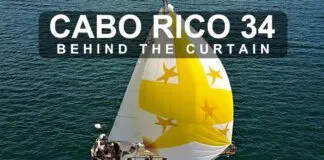
Cabo Rico 34 Boat Review

Super Shallow Draft Sailboat: The Leeboard Sharpie

Hans Christian 41T – Boat Review

Seven dead after superyacht sinks off Sicily. Was the crew at...
Latest sailboat review.
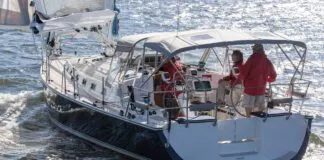
- Privacy Policy
- Do Not Sell My Personal Information
- Online Account Activation
- Privacy Manager
How to Articles | Bottom Paint Store
Learn more about boat paint applications and marine supplies.


How to Choose and Apply Non-Skid Boat Deck Paint for Safety and Durability
Why Non-Skid Deck Paint is Essential
Safety on boats is crucial, particularly on decks where water can create a slipping hazard. Whether for recreational purposes or professional boating, non-skid surfaces are essential to prevent accidents and ensure stability. Non-skid deck paint offers a practical solution that enhances traction and improves the overall appearance of the boat, making it a popular choice among boat owners.
Types of Non-Skid Deck Paint
One option is textured paint, which incorporates non-slip additives like silica, polymer beads, or rubber to create a rough surface that improves grip. Textured paints are commonly used in areas exposed to water, providing excellent traction. Another type is pre-mixed non-skid paint, which is convenient and easy to use, making it ideal for DIY enthusiasts. These paints come ready to apply with the non-slip additives already mixed in, ensuring consistency in texture. Some prefer additive-based non-skid solutions, which allow users to mix non-skid additives such as sand, silica, or specialized granules into regular marine paint. This offers the flexibility to customize the texture and non-slip performance based on individual needs.
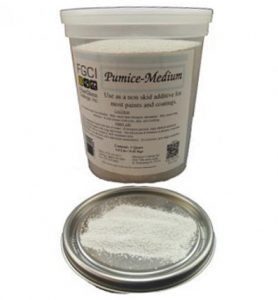
Non-Skid is a pumice additive that can be added to most paints and gel coats to provide a slip resistant surface. Learn more.
Key Factors to Consider When Choosing Non-Skid Deck Paint
Durability is one of the primary considerations when selecting non-skid paint. The paint should be able to withstand marine conditions such as saltwater exposure, UV rays, and heavy foot traffic. Choosing a durable paint ensures that the non-skid properties remain intact over time. Ease of application is another important factor, particularly for those who plan to apply the paint themselves. Pre-mixed options simplify the process, while additive-based solutions offer more customization but require additional effort to prepare. Aesthetic preferences should also be taken into account.
Non-skid deck paints come in a variety of colors and finishes, giving boaters the ability to match their deck to the overall look of the vessel, whether they prefer a sleek, modern design or something more traditional. Additionally, it is essential to ensure the paint provides waterproofing to prevent water damage and includes UV protection to maintain the paint’s integrity under prolonged sun exposure. Both of these features contribute to the longevity of the paint.
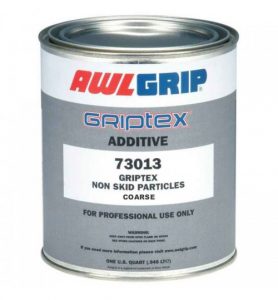
Griptex is a polymer bead aggregate used to provide non skid deck and step areas when mixed with an Awlgrip topcoat. Learn more.
Step-by-Step Guide to Applying Non-Skid Deck Paint
The first step is preparation. Start by thoroughly cleaning the deck to remove any dirt, grease, or old paint that could interfere with the adhesion of the new paint. Once clean, sand the surface to create an even texture that allows the paint to bond properly. After sanding, wipe down the deck with a solvent to remove any remaining dust or debris, ensuring a clean and smooth surface.

Priming the deck is the next step, and depending on the paint you select, a marine-grade primer may be necessary. This primer helps the paint adhere to the surface more effectively and improves durability. When it comes to painting, apply the non-skid paint with a brush or roller, ensuring even coverage across the deck. It’s important to apply multiple thin layers rather than one thick coat, as this improves the durability and performance of the non-skid properties. Allow for sufficient drying time between each coat. Once the final layer is applied, give the paint ample time to cure before exposing the deck to foot traffic or water, as rushing this step can reduce the effectiveness and lifespan of the paint.
Maintenance Tips for Non-Skid Boat Deck Paint
To maintain the effectiveness of the non-skid surface, it’s important to clean the deck regularly using mild soap and water. Dirt and debris can accumulate over time, reducing traction and making the surface less safe. It’s also best to avoid using abrasive cleaners, as they can wear down the non-skid texture, diminishing its performance. Instead, opt for gentle cleaning methods that preserve the surface. In high-traffic areas, the paint may wear down over time. Periodic touch-ups or repainting may be necessary to maintain the non-skid properties, especially in areas that experience heavy use.
Top Non-Skid Deck Paint Brands
There are several reputable brands known for producing high-quality non-skid deck paints that combine durability, ease of use, and long-lasting performance. Interlux is recognized for its exceptional durability and UV resistance, making it an excellent choice for long-term use. TotalBoat offers a range of easy-to-apply paints that provide excellent traction and are favored by DIY boat owners. KiwiGrip is popular for its environmentally friendly formulation and customizable texture, allowing boaters to adjust the level of non-skid based on their needs. Rust-Oleum is a budget-friendly option known for its durability and resistance to water, making it a practical choice for those seeking a cost-effective solution.
Enhance Safety and Aesthetics with Non-Skid Paint
As you can see choosing the right non-skid deck paint is essential for ensuring both safety and aesthetics on your boat. By selecting a paint or additive that balances durability, ease of application, and visual appeal, you can enjoy a safer, more attractive deck that stands up to marine conditions. Investing in non-skid paint enhances your boating experience, providing peace of mind while also improving the overall appearance of your vessel. If you need any assistance selecting non skid boat paint feel free to contact the customer support team at Bottom Paint Store.

Ridetheducksofseattle is reader-supported. When you buy through our links, we may earn an affiliate commission. Learn more
The Best Boat Deck Paints (Non-skid, Fiberglass, Wood & More)
Written by Anthony Roberts / Fact checked by Jonathan Larson
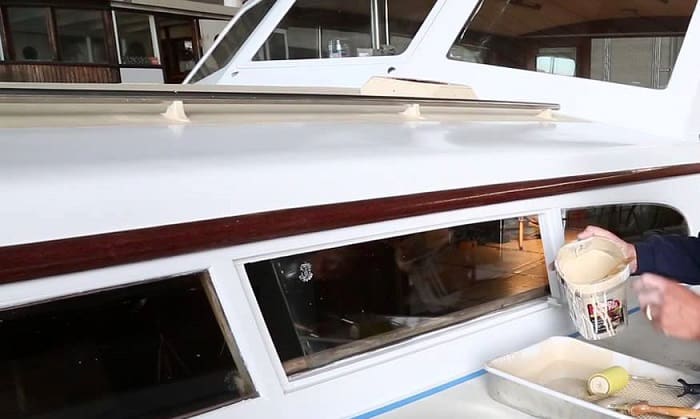
Unlike indoor areas, the boat deck is exposed to various elements such as rain, sun, and wind. The wear and tear of frequent sailing is another thing to worry about. So, it’s a good measure to settle for the best boat deck paint. To get it, you have to be certain of the following factors:
- Protection: A stunning finish is a normal thing to expect from boat floor paint. But it’s also crucial that it guarantees the safety of those who step on the boat’s floor. It needs to have water and slip resistance like epoxy boat floor paint. When the paint is not easily washed away, peeled, or cracked, it protects decks and surfaces well.
- To establish a slip-resistant surface, paint texture and formula are the components. Non-slip deck paint can also be applied to accessories like deck chairs where you can sit comfortably.
- Color: Color plays a big role in promoting a lovely finish that suits your deck. It won’t be hard to pick the one that you like since there’s a wide range of available colors. Just so you know, the white color will allow you to be barefooted since it remains cool even under the sun. When you choose dark-colored deck paint, it’s advisable to wear your shoes even onboard.
- Durability: The paint for the boat floor must be tough enough to bear foot traffic, UV rays, and rough weather conditions. For example, the best non-skid boat deck paint creates a durable finish that doesn’t cease to protect.
Now that you are aware of the factors that you have to take note of, look through these boat deck paint reviews to choose one that suits you.
TotalBoat Deck Paint
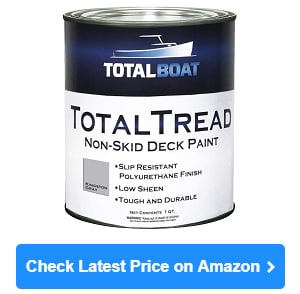
| + Creates a durable, textured finish |
| + No peeling and fading |
| + The tiny particles are not sharp |
Jump to Review
Rust-Oleum 206999
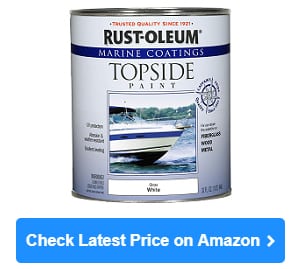
| + Used in different painting jobs |
| + Smooth finish |
| + Creates a protective layer |
KiwiGrip Non-Skid Coating

| + Can make your preferred texture |
| + Prevent slipping |
| + Covers scars and dings |
Table of Contents
1. TotalBoat TotalTread Non-Skid Deck Paint
2. rust-oleum 206999 marine topside paint, 3. kiwigrip non-skid coating, 4. totalboat 365399 wet edge marine topside paint, 5. liquid rubber smooth polyurethane deck coating, 6. rust-oleum 207009 marine anti-slip additive, 7. tuff coat ut-211 light gray non-skid coating, buyer’s guide, what kind of paint should i use on my boat deck, how should i prepare my boat deck before painting, how do i paint a fiberglass boat deck, how do i paint a wooden boat deck, top 7 boat deck paint reviews.
The tiny plastic beads make this stand out among anti-slip paints. They are way better than sand mixed and are so small you can’t easily spot them. Once the paint dries, you’ll be happy with a durable, textured surface. This is not only paint for fiberglass boat decks as it can adhere to wood, metal, aluminum, and previously painted surfaces, too.
The silica in this formula makes the finish easy on bare feet. I like how the surface isn’t slick after a water splash or rain. As mentioned, it’s durable so peeling and fading won’t occur. Although scrubbing is done for maintenance, I and my crew can still have a secure footing without compromising comfort.
I’m more than satisfied with its effect on the deck and cockpit of my boats. Hence, I used it in replacing the old Spalding basketball backboard that has been rotting for years. It made my son who’s crazy about basketball so happy! It’s been a year since I did this project, and this proves that it can protect the wood from warping.
Every purchase of this non-skid deck paint comes with gloves and a stir stick. Before application, it needs to be mixed properly. To ensure that I do it efficiently, I use a drill mixer. I must say that two coats are essential as the first one may show inconsistent layers, especially where the particles are only contained in a certain area. It’s fixed by the second coating.
- Creates a durable, textured finish
- Not slick even splashed with water
- No peeling and fading
- The tiny particles are not sharp
- Protects wood from warping
- Can revive and maintain a fiberglass
- Needs to be mixed well to achieve the desired result
- Two coatings are a must
I’ve heard from the boaters in my area that they use it for their boat hulls. The description recommends it for above the waterline use, so I ventured to have it on my deck. To my delight, it serves well as a boat floor coating. I was amazed when I saw it cover cracks and scratches. I love the smooth finish with a display of elegance too. On top of these benefits, it’s boat deck paint on a budget.
The gloss is just right because I think it can be slippery if it’s too glossy. It’s just my opinion on its finish that is akin to hard plastic. Apart from fixing and enhancing fiberglass, wood, and metal surfaces, it builds a protective layer against UV rays and bad weather conditions.
My boats and marine accessories are not the only ones that benefit from this quality deck paint. My once butterscotch-colored bathtub turned into its original white color after I applied it. It bonds well with the fake granite countertop in my kitchen. Therefore, it’s dependable for every painting job.
- Can cover cracks and scratches on fiberglass
- Smooth finish with enough gloss to not make surfaces slippery
- Creates a protective layer against UV rays and bad weather conditions
- Can be applied on fiberglass, wood, and metal surfaces
- Used in different painting jobs
- Levels well and can be sprayed or applied manually
- Needs to be thinned out to dry quickly
- Has a strong scent
Restoration of my 15-foot bass boat is a success because of this non-skid paint. I made the right decision of replacing the carpet on my deck with anti-slip decking paint. Aside from the bass boats and aluminum boats, this can bond on fiberglass surfaces. You may apply it on a wooden deck but you have to prime the area first. Also, it can stick on concrete.
I can say that this is the best paint for the boat deck because I can control the texture. I prefer just a little texture so it won’t be bothersome to my feet. Enough traction is what I need to prevent slipping and other accidents on wet decks. You can practice on a scrap piece to get the texture that you like.
There are black and pastel boat deck paint colors to choose from you. The light colors are selected so the non-skid properties are not destroyed. I’m even more impressed when I found out that it can cover scars and dings. Thus, I didn’t think twice about using it on my 30-year old boat that was not in use for many years. You don’t have to hesitate to include this in your kit to restore water vessels.
- Can be on metal, aluminum, fiberglass, and wood surfaces
- You can make your preferred texture
- Prevent slipping even though the deck is wet
- Covers scars and dings
- Good for water vessel restoration
- The need to move fast working under hot weather to be able to level the finish
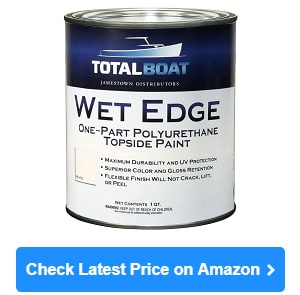
The deck area is where people usually walk going back and forth. Due to this, I can be at ease with the durable and glossy finish of this product. It creates a beautiful layer that is resistant to scratches, abrasion, and chemicals. I can attest that this paint can last for many years and repainting doesn’t need to be done frequently. Most importantly, the durability gives me peace of mind.
The thick finish can let the old boats regain a new look. I even used it to correct the recent paint job done by the previous owner of the boat that I bought. After the vessel is painted, it stands out when it sits beside other boats.
Aside from being the paint for fiberglass boat floor, it’s applicable for metals, wood, and previously painted surfaces. So, you can have it as a pontoon deck paint. Several people use it to maintain their swimming pools in presentable condition. The manufacturer is right when introducing this as submersible because the paint stays the same even when it gets wet.
- Creates a durable and glossy finish
- Resistant to scratches, abrasion, and chemicals
- The thick finish is useful on old boats and fixing painted surfaces
- Can be on different surfaces
- Not easily tainted when it gets wet
- Can dry quickly
- It can sag or run when not applied thinly
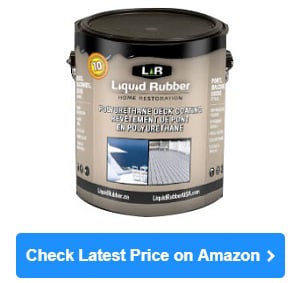
I was desperately looking for marine paint for wood decks because of the substandard materials added by the builder to my deck. Since I don’t have a budget to replace the wooden parts, I opted for something like a composite deck. This is the right paint for my plans and I chose the texture light gray. There are various colors and you can also choose a smooth finish. It all depends on your preference.
It protects the deck very well despite the exposure to torrential downpours and tropical sun for a long period. That’s how dependable its thick layer is. It’s not the regular deck paints that flake off in a few years. I must say that its result can please boat owners. It can also be used on the dock kit that I assembled.
You may also apply it on concrete surfaces based on its efficacy on a couple of projects. To give a few examples, our balcony that looked gray and worn off is now wonderful. I tried so hard to stop the leaking in the stone garage when it rains. The issue was resolved after I used it on the cement deck over the garage. It’s a clear testimony that it covers surfaces completely.
- Various colors and types of finish
- Protective against torrential downpours and tropical sun
- Doesn’t flake off easily
- For wooden and concrete surfaces
- Can stop leaking
- Not slippery or too hot to step on even though it’s exposed to the sun
- More time for application
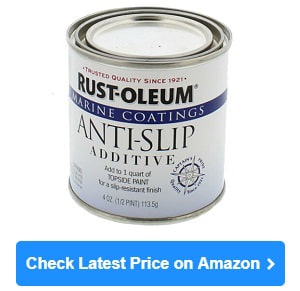
Safety concerns oblige me to get excellent deck paint for the aluminum boat. This product is the right candidate since it’s slip-resistant deck paint. But it can be on different boat decks as it can stick to other materials. Aside from being skiff or pontoon boat deck paint, it’s applicable for fiberglass, wood, and painted surfaces. As an additive, you can mix it with oil-based or latex paint.
You can expect longevity from its finish as it has survived high traffic. The anti-slip result is perfect for the boat’s deck and floor. No more fear of backflipping during damp mornings. This also assures my elderly mother that she can get on my pontoon without tripping. I also use it on her ramp. Our front door at home is no longer slippery after I mixed some of this with the cement paint.
As you can observe with the various applications, it’s indeed for interior and exterior use. When water and snow stay on the finish, I just sweep them off. It gives me relief to see that nothing bad happened. I thought that I needed to repaint the deck but fortunately, it’s not necessary when you have this waterproof paint.
- Survives high traffic
- Non-slip, waterproof coating to prevent accidents
- For interior and exterior use
- Not easily damaged by snow and rain
- Can be applied directly without mixing with oil-base or latex paint
- Application in small batches can be time consuming
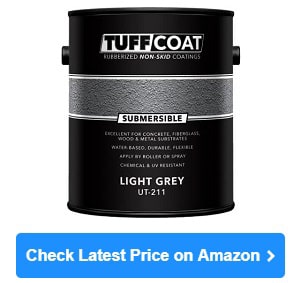
It’s unquestionably marine-grade paint because of the finish that it makes. It has a non-skid additive in the form of recycled rubber tire granules. So, you can ditch the carpet that you use on your deck and spare yourself from the demands of cleaning. It’s an outstanding paint as I can make a durable coating that is slip resistant at the same time.
You may think that this is a boring kind of paint because of its inclination to durability. But it’s available in 15 shades so you can choose the one that spices up your boat’s look. When there are blemishes, scars, and stains on fiberglass surfaces, you can use it to cover those areas. Thus, it doesn’t only prevent surfaces from being slick and slippery but it enhances the appearance as well.
Apart from fiberglass boat decks, it has remarkable effects on aluminum boats. My fellow boater also painted this on the floor of an enclosed trailer. The effect is superb just like how it goes with the exterior surfaces. Furthermore, I’m surprised that it’s also great on wooden decks so it’s like sailboat deck paint too! With these revelations, the durable coating of this paint is versatile.
- Delivers a durable, non-slip coating
- Can hide blemishes, scars, and stains on fiberglass surfaces
- Has remarkable effects on various materials whether interior or exterior part
- Has resistance to impact
- Doesn’t have a strong odor
- Dries in just half an hour
- Application is time-consuming
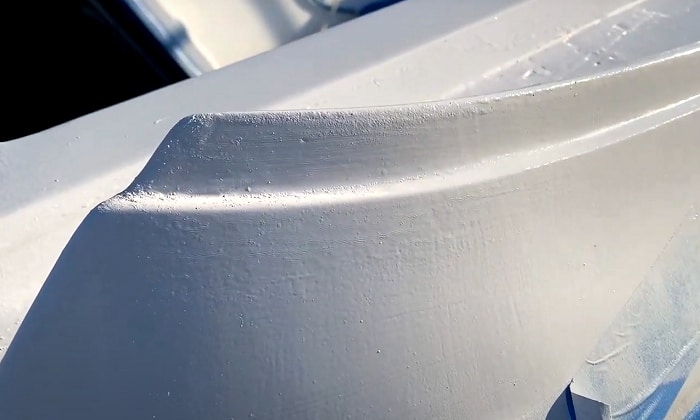
Types of Boat Deck Paint
The market offers a wide range of marine deck paints. In terms of ingredients, the usual ones are oil-based paint, acrylics, and linear polyurethane. Some of these paints have ground rubber or tiny particles to create a non-skid finish.
Among the formulations, polyurethane paint proves to be great at resisting UV rays, water, solvents, and oils. High-quality paint protects the deck against harsh elements so your deck and boat won’t be easily damaged.
- These paints can fill up gaps and cracks. They can cover the effects of outdoor elements. Moreover, you may use it to fix the damaged and faded areas on different surfaces.
- Deck paints are available in various colors so you can choose one for aesthetic enhancement. Faded and aged colors can be replaced with ease.
- These paints protect wooden surfaces very well. They can repel UV damage, rotting, and molds. Thus, your wooden deck is in good shape as long as you cover it with reliable deck paint.
- Most boat owners would spread a carpet on the boat’s floor. However, you have to clean it from time to time. If you paint your deck with a good product, you can make a tough finish that requires effortless cleaning.
The kind of paint that you should use on your boat deck is the one formulated to protect against daily wear and tear. Furthermore, it must shield the deck and floor from foot traffic, harsh sunlight, water, and wind. It typically can eliminate flex damage and cracks caused by freezing. You can also find one that stops leaking issues.
If you’re worried about slipping issues because the deck is exposed to water and rain, choose paint that has slip resistance and is comfortable to bare feet.
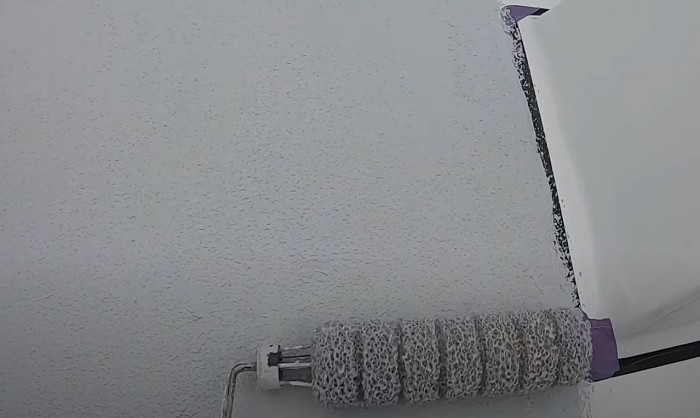
Here are some necessary preparations so you can continuously paint your deck without interruptions.
- Remove all the hardware like plastic, aluminum window frames, and sliding doors. It must be done before starting to paint. For instance, the paint can mess up objects made of plastic.
- Just a brush of the paint can sometimes be wrong as you need to complete necessary repairs like rotting sections and damaged areas. It’s a crucial step to achieve the expected result.
- The temperature affects the outcome and drying time so you have to be conscious when you begin the painting process. Too much heat at noon is not good as well as late afternoon because cooling temperature and moisture in the air have unfavorable effects. A sunny day is an ideal time to paint.
- When you need to sand and vacuum the service, get rid of the dust and residue. You can make sure that there is no residue by smacking the surface with a towel. Then, sweep and vacuum if it’s still needed before you wipe the area with a clean cloth.
- Read the manufacturer’s instructions so your work won’t be interrupted. You may stop at one point and wonder about the next thing that you need to do. To avoid this, familiarize yourself with the necessary steps. It’s also a way to achieve the expected result.
- You may use a primer or not since it’s not a must for fiberglass boats. If you opt for a primer, you need to make sure it’s compatible with your chosen paint.
- When the layer of primer is done, you can lightly sand it before proceeding to the second coating. It’s advisable to begin painting two hours after the completion of the primer.
- Mix the paint as instructed by the manufacturer.
- Start painting on the edges as you go and you can work your way to the middle. You’ll also need to put tape on the edges of the area you intend to paint.
- Although it appears that the paint has dried, it’s best to let it sit for 24 hours or the time recommended by the manufacturer. Protect the surface from debris and bugs from sticking.
- Sanding the wooden surface is crucial to ensure that the paint adheres well and the result is great. You may use a disc sander or orbital sander. Sandpaper is also needed in some cases. The coarseness will depend on the wood condition. Pick the coarser one if there are a lot of undesirable spots to scrape.
- After sanding, you have to clean the area and get rid of the tiniest particles. You can use a vacuum to get rid of the dust.
- It’s recommended to use a primer for bare wood. A single coating is fine but the second coating is pretty good. Choose the metallic primer because it’s watertight.
- When applying the paint, you should follow the direction of the wood’s grain. Scratches that are caused by sanding won’t be obvious if you do it. Avoid over-applying and just put the right amount of paint in the brush or roller. It’s best to apply thinly.
- Drying is quick during warm days. While drying, make sure that nothing sticks on the surface.
Decks can be made of various materials. A single deck may have various components but with the best boat deck paint, you won’t need any other substance as it can adhere to different materials. The right paint protects your deck against sunlight, rain, snow, wind, water, and other harsh elements in the long run. It also prevents accidents that can occur from slippery boat floors.

Ten years of enjoying countless trips on boats never made me love them any less! So I am here to put all those experiences into good use for other boaters who want to have a safe and fun trip with their friends and families.

- Boat Accessories
- Where to Buy

Special until September30th: 20% off Git-Rot (all sizes). Use Code SEPT24 at checkout. *restrictions apply
Free ground shipping in the Continental US for any orders over $150!
How To Paint a Boat Deck...
How to paint a boat deck.
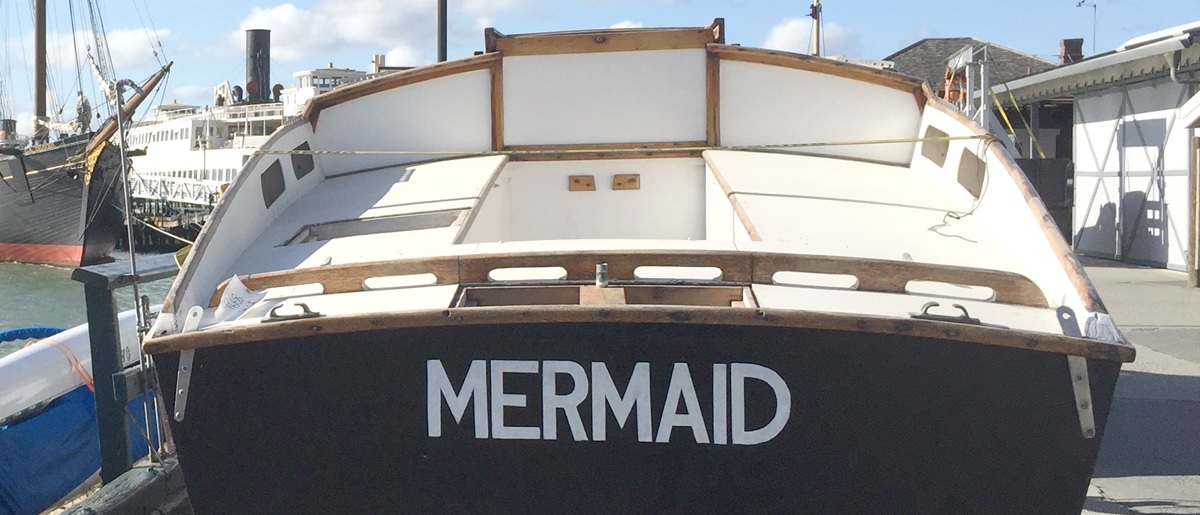
Painting the deck of your boat can bring back much of its original beauty. Plus, a fresh coat of paint can improve the safety of your craft, as old paint can be quite slippery. So, if you’d like to restore the look and safety of your vessel, read on tips from BoatLIFE on how to paint a boat deck.
Prepping for New Paint
The success of your paint job will largely be determined by the quality of your preparation. By spending the time upfront getting your boat ready for new paint, you will be far more likely to get great results in the end. Here’s what you need to do to prepare your boat:
- Pick the right time and place . Painting a boat deck in the wrong conditions is a recipe for disaster. If possible, it’s ideal to do this job indoors, where you can eliminate weather conditions as a concern. If such a situation isn’t available to you, plan the job for a time of year when dry weather is the norm. Keep an eye on the forecast and adjust your plans to stay away from any possible rain.
- Remove old paint . It might be appealing to lay down the new paint right on top of the old coat, but you should resist this temptation. You’ll get far better results by stripping away the old paint and starting over. Sanding the deck thoroughly can take away that faded old paint and provide you with a surface that is ready to take a fresh coat properly.
- Clean the work area . Use Boat Cleaner to ensure the deck is as clean as possible before applying any paint. Vacuum up any dust or small pieces of debris on the deck, and also clean any sticky residue that may be present with Release Adhesive & Sealant Remover . Be sure to let the deck dry thoroughly before the painting process begins. Also, this is a good time to use tape to protect any areas that are not going to be painted.
Create a Plan
It’s easy to paint yourself into a corner on a boat. There is only so much room to move, and the size of the surface is not that big. If you start painting without a plan, you may run out of room and be stuck surrounded by wet paint. Depending on the shape of your boat, it might be best to work in sections rather than trying to tackle the whole job at once. That would make it easier for you to leave one portion dry so you can walk around and reach the other parts safely.
Pick the Proper Paint
Selecting the appropriate paint for your boat is crucial. Some of the leading options include oil-based paint, linear polyurethane, and acrylic paint. If you aren’t sure what will work best for your craft, ask for help at a marine supply store.
As you select your paint, you should consider the need for an anti-slip surface. Some of the paints on the market have anti-slip designed into their formulas. If that is not true for the product you choose, consider using an additive to make sure the finished product has a good feel under your feet.
It’s important that you stay patient throughout this process. The prep and painting of your boat can be lengthy, and so can the time it takes for the paint to dry. If you rush out and use your boat before the paint is fully cured, you’ll do damage to the new paint job and more work will be required.
Use BoatLIFE Products
Now that you know how to paint a boat deck, purchase many of the necessary products for the job from BoatLIFE ! We look forward to serving you.
Share this:
- Click to share on Twitter (Opens in new window)
- Click to share on Facebook (Opens in new window)
Featured Products
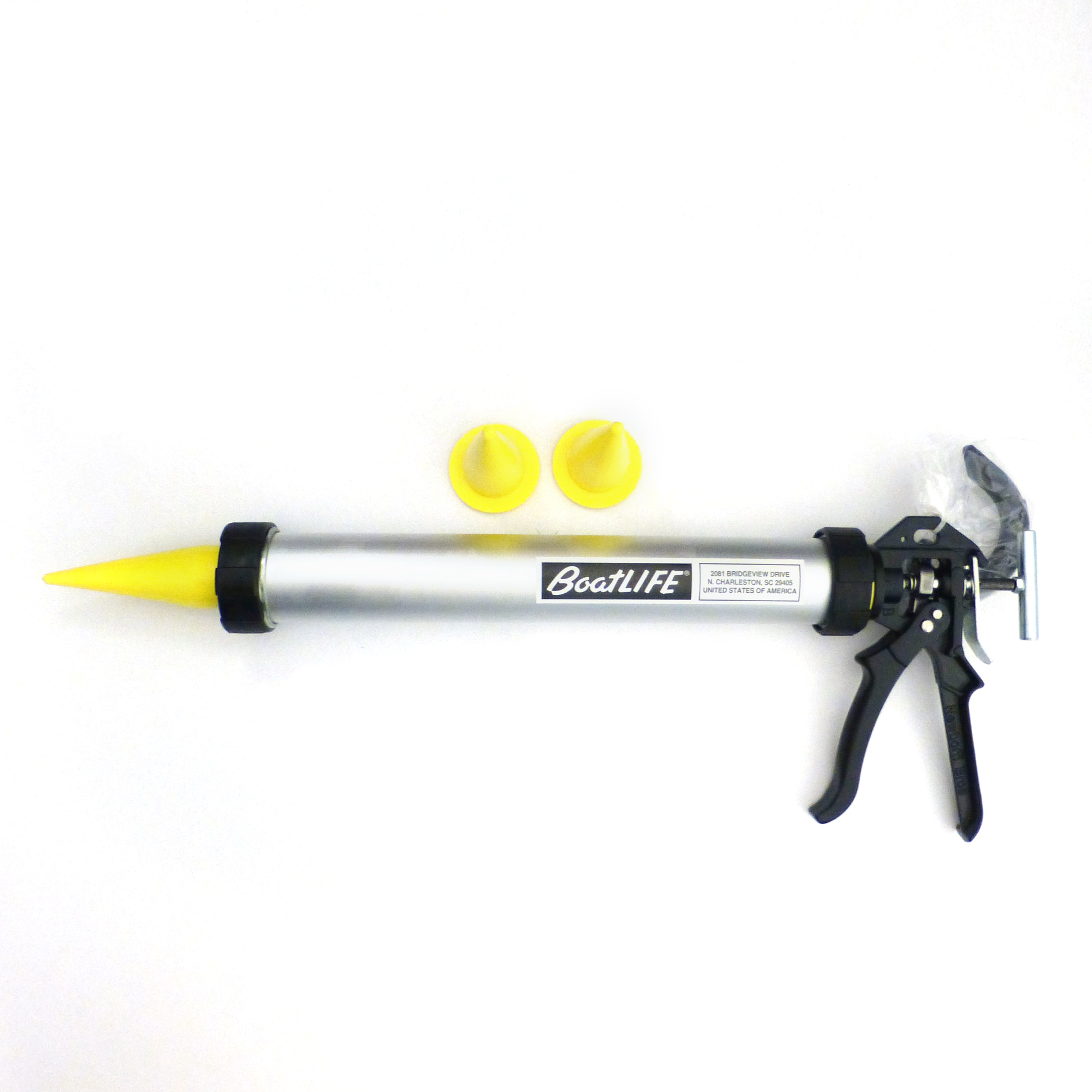
Liquid LifeSeal® Sealant 5.2 fl. oz. Clear

Stainless Steel Cleaner 16 fl. oz.
Related blogs, how to paint a fiberglass boat.
Caring for your fiberglass boat takes time, money, and a lot of patience. One aspect of maintaining your investment is […]
Replacing Fiberglass Flooring on Your Boat
Here at BoatLIFE, we’ve been in business over 65 years perfecting the art of DIY boat maintenance, boat restoration, and […]
Thanksgiving Trivia!
Happy Thanksgiving! Thanksgiving is one of America’s oldest and most loved holidays. Although the story is steeped in a dark […]
All products proudly made in the usa

Free Shipping On All Orders!
- Epoxy Resins
- Polyester Resin
- Urethane Resins
- Epoxy Project Supplies
- Antifouling Paints
- Topside Paints
- Thinners & Solvents
- Paint Supplies
- Wood Oils & Finishes
- Wood Finishing Supplies
- Cleaning & Polishing
- Accessories
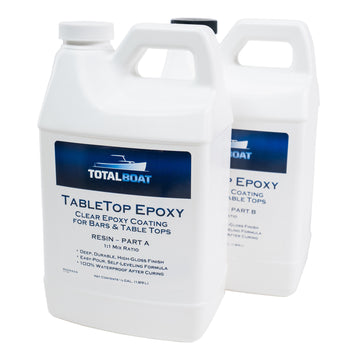
Table Top Epoxy
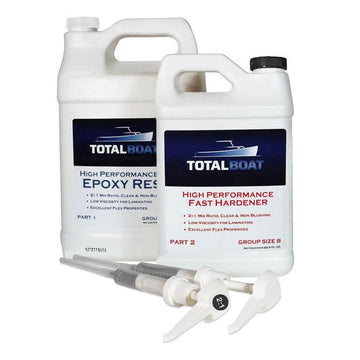
Clear High Performance Epoxy Kits
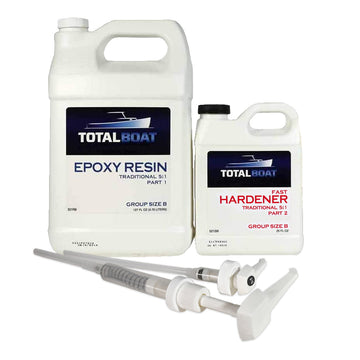
5:1 Traditional Epoxy Resin Kits
- Thinners & Solvents
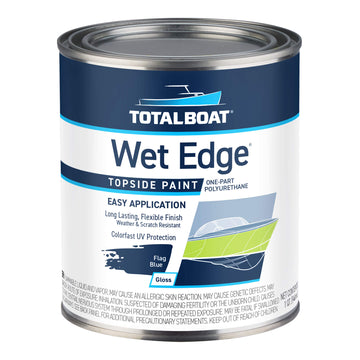
Wet Edge Topside Paint
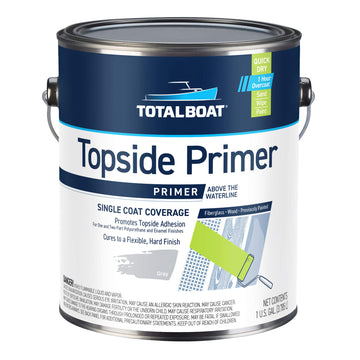
Premium Marine Topside Primer
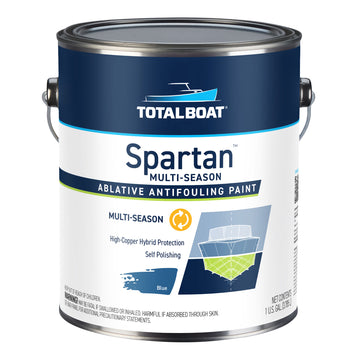
Spartan Multi-Season Antifouling Paint
- Wood Finishes
- Wood Oils & Finishes
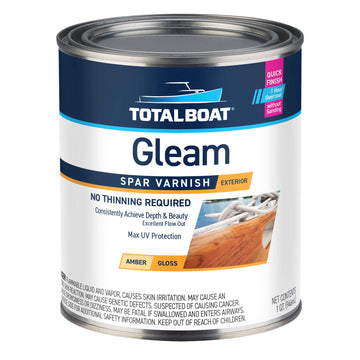
Gleam Marine Spar Varnish
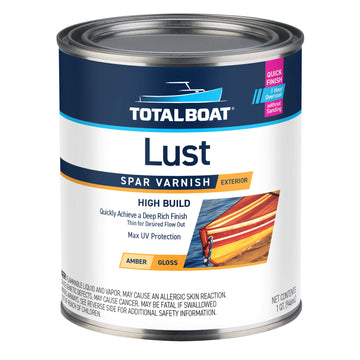
Lust Rapid Recoat Marine Spar Varnish
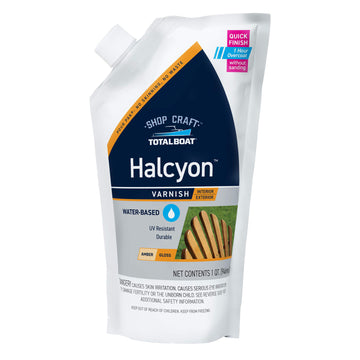
Halcyon Water-Based Marine Varnish
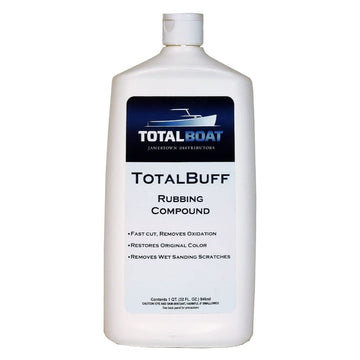
TotalBuff Rubbing Compound
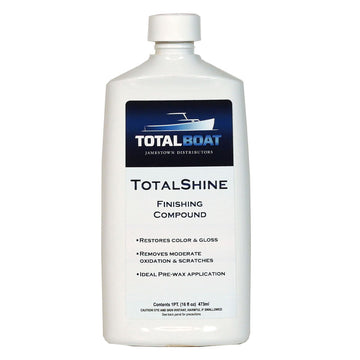
TotalShine Finishing Compound
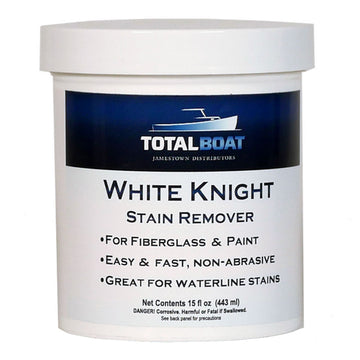
White Knight Fiberglass Stain Remover
- TotalBoat Gear
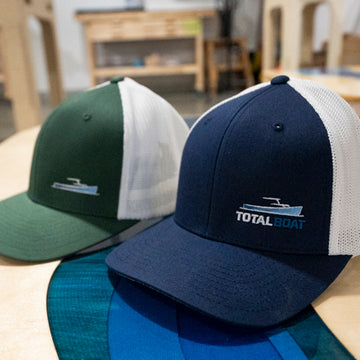
FlexFit Fitted Mesh Back Baseball Cap

Men’s Long Sleeve T-Shirt Hoodie
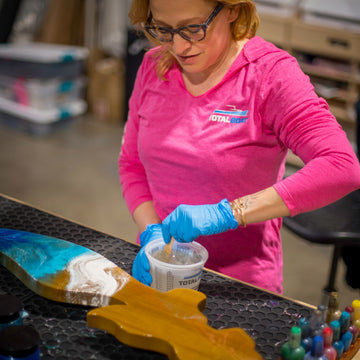
Women’s Long Sleeve T-Shirt Hoodie
FREE SHIPPING with a minimum puchase of $1,200.00 You are $10.00 away from your free shipping!
Shipping, taxes, and dicount codes calculated at checkout.


FOUR POPULAR COLORS
UV STABLE, LOW GLARE
LONG LASTING, LESS GRITTY
EASY TO APPLY
TotalTread Non-Skid Marine Deck Paint
Couldn't load pickup availability
- Description
- Frequently Bought Together
- Product In Action
- Specifications
- You May Also Like
Less gritty 'grit' has greater grip and longevity
Particle size matters. The round Propyltex™ particles in TotalTread are less abrasive than traditional silica, but more abrasion resistant. They come in a range of sizes, each with a different purpose. Some make sure the coating grips and lasts. Others lower the gloss level to prevent eye-straining sun glare on a wet deck. Some create a smooth feel underfoot. It doesn’t hurt to walk barefoot on it, and if you do hit the deck it won’t hurt nearly as much as old fashioned ‘sand’ non-skid additives do.
Masking is the hardest part of applying TotalTread
The non-skid stuff in TotalTread has a low density so it stays suspended in the paint. Unlike other slip-resistant deck paints, the particles won’t float to the top, or sink to the bottom. Mixing is easy and quick, and doesn’t require a trip to the local paint store to have them give it a ride on the shaker for you. Because the particles stay suspended in the paint, it’s easy to lay down an even coat of consistent texture. You don’t have to keep stirring the paint to keep the particles in play. The most time-consuming painting task is masking off areas where you don’t want TotalTread.
More coats equals more grip
High-solids TotalTread will cover completely in one coat. However, we recommend two coats to get the best combination of grip and durability. If you want even more texture, apply a third coat.
Looks cleaner after cleaning
Sounds obvious, but hard-scrubbing traditional non-skid coatings can leave ugly dark specks where the silica particles wear through. TotalTread is easier to clean because it’s less abrasive. And because it’s more abrasion resistant, the only thing hard scrubbing does is make it look as good as the day it was applied.
Create a custom non-skid color
Like the texture, but not the tint? Concocting your own color is easy. Just mix TotalTread colors, or blend a TotalTread color with a TotalBoat Wet Edge color.
Not just for your boat’s deck
Use TotalTread slip resistant paint where extra traction is needed, such as wooden stairs, steps, and docks.
How to apply maintenance coats of TotalTread
After a few years of use/exposure, you may want to recoat TotalTread to improve the color or texture, as the grit can wear down over time, especially in high-traffic areas. To recoat, clean/dewax the surface and scuff lightly with 220-grit or 320-grit sandpaper or a maroon Scotch-Brite pad. Scuffing will naturally knock some of the grit down. Remove scuffing residue and apply at least one, maybe two coats of TotalTread for a more true color and desired grit.
TotalTread Non-Skid Deck Paint Details
- Resilient, one-part polyurethane resin ready-mixed with unique Propyltex™ texturing agents for a tougher, slip-resistant surface.
- High-tech texturing additive adheres better and looks better longer than traditional silica non-skid additives.
- UV stabilizers allow colors and finish to withstand heavy use and harsh weather without fading, cracking, or peeling.
- The amount of texture is determined by the number of coats applied. More coats equals greater texture.
- Apply over fiberglass, wood, and previously painted surfaces in good condition.
- Colors: Available in Light Gray, White, Kingston Gray, and Sand Beige. The White, Kingston Gray, and Sand Beige colors match our TotalBoat Wet Edge Topside Paint colors. NOTE: The new Light Gray color was created for those who like their gray a little lighter, a little warmer, and a little less blue in tone. In comparison, Kingston Gray is a little darker and a little more blue in tone than Light Gray.
- Sizes: Quarts and Gallons
FREQUENTLY BOUGHT TOGETHER
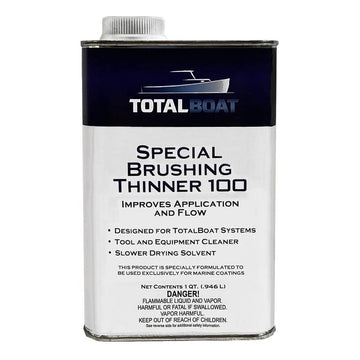
Special Brushing Thinner 100
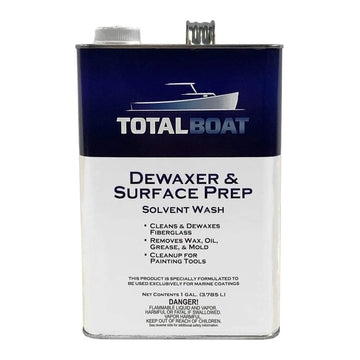
Dewaxer & Surface Prep Solvent
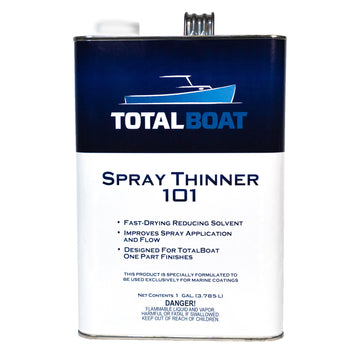
Spray Thinner 101
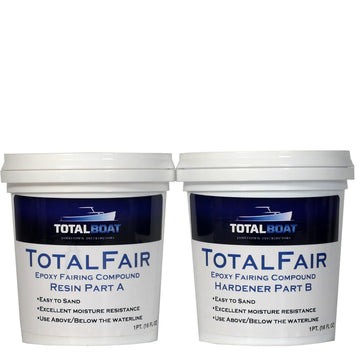
TotalFair Epoxy Fairing Compound
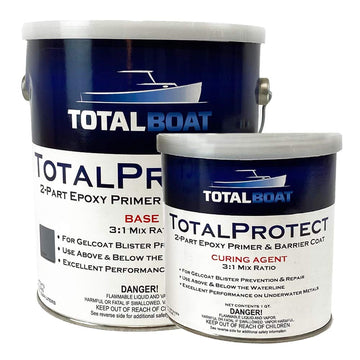
TotalProtect Epoxy Barrier Coat Primer
SEE HOW EASY IT IS TO USE TOTALTREAD
TECHNICAL DATA
- Substrates: Fiberglass, wood, previously painted surfaces, epoxy, properly prepared metal substrates
- Application Method: Brush, Roll, or Spray
- Application Temperature/RH: 50-90°F, relative humidity less than 85-90%
- Application Film Thickness: 1-2 mils dry @ 3 mils wet
- Number of Coats: 1-2
- Tack-Free Time: 1.5 hours @ 90°F, 3 hours @ 70°F, 6 hours @ 50°F
- Minimum Overcoat Time: 8 hours @ 90°F, 12 hours @ 70°F, 16 hours @ 50°F
- Colors: White, Sand Beige, Kingston Gray, Light Gray
- Finish: Flat, gritty
- VOC Content: Varies by color
- UV Stable: Yes
- Food Safe/Food Contact Safe (Once Cured): No
- Coverage (@ 3 mils wet): 80-100 square feet per quart, 350-400 square feet per gallon
- Primer: TotalBoat Topside Primer (wood and previously painted surfaces; not needed on properly prepared fiberglass), TotalBoat 2-Part Epoxy Primer (Metals), TotalBoat TotalProtect Barrier Coat (Fiberglass/Metals), TotalBoat Aluminum Boat Barrier Coat (Metals)
- Thinner: Brushing/Rolling - TotalBoat Special Brushing Thinner 100, 5-10%, if needed; Spraying - TotalBoat Spray Thinner 101, 10-20%, if needed
- Surface Prep Solvent: TotalBoat Special Brushing Thinner 100 or TotalBoat Spray Thinner 101 or TotalBoat Dewaxer & Surface Prep
- Cleanup Solvent: TotalBoat Special Brushing Thinner 100 or TotalBoat Spray Thinner 101 or TotalBoat Dewaxer & Surface Prep
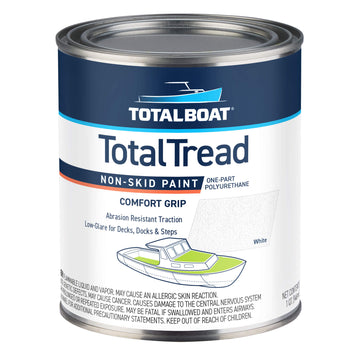
- Interior/Exterior?
- Application methods:
- Application temperature & humidity:
- Number of coats:
- UV Resistant?
- Best for: Provides a non-slip surface on decks, docks, ramps, steps, cabin soles & other fibergalss and wood topside surfaces.
- Interior/Exterior? Exterior (above the waterline only)
- Thinner: Brushing/Rolling: TotalBoat Special Brushing Thinner 100, 5-10%, if needed; Spraying: TotalBoat Spray Thinner 101, 10-20%, if needed
- Application methods: Brush, roll, or spray
- Application temperature & humidity: 50-90°F; humidity 0-90%
- Number of coats: Two; between coats, sand lightly with 220-grit sandpaper
- Cleanup: TotalBoat Special Brushing Thinner 100 or TotalBoat Spray Thinner 101 or TotalBoat Dewaxer & Surface Prep
- Coverage: 250-300 sq. ft. per gallon
- UV Resistant? Yes
- Painting wood and fiberglass boat hulls above the waterline
- High gloss (all colors); Flat (black, white, and gray only)
- Interior and exterior (above the waterline only)
- TotalBoat Topside Primer (NOTE: Wet Edge can also be applied over TotalBoat epoxy primer systems, including TotalProtect, 2-Part Epoxy Primers, and Aluminum Boat Barrier Coat. See technical data sheet for details.)
- TotalBoat Special Brushing Thinner 100 (brush/roll) or TotalBoat Spray Thinner 101 (spray)
- Brush, roll and tip, or spray
- 50-90°F; humidity 0-90%
- 2-3 (minimum)
- TotalBoat Special Brushing Thinner 100 or TotalBoat Spray Thinner 101 or TotalBoat Dewaxer & Surface Prep
- 350-400 sq. ft. per gallon (approximately 80-100 sq. ft. per quart)
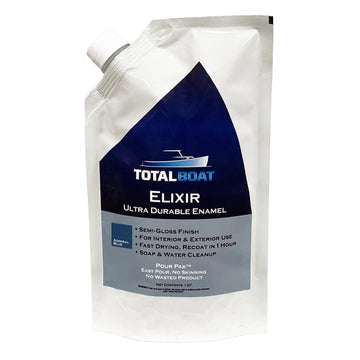
Elixir Enamel Topside Paint
- Painting signage and wood, fiberglass & metal boat hulls above the waterline
- No primer needed.
- Water, if needed, up to 20%
- Brush, roll and tip, or spray. For brushing, use a tapered polyester brush; for rolling, use a high-density foam roller cover.
- Soap and water
- 80-100 sq. ft. per quart (3 mils wet film thickness)
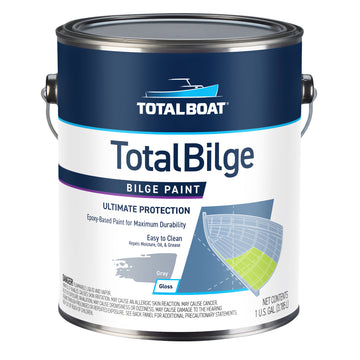
TotalBilge Epoxy Bilge Paint
- Painting bilges, bulkheads, lazarettes and locker areas
- Interior only
- TotalBoat TotalProtect — only mandatory on metals, but may be used on properly prepared wood or fiberglass, if desired.
- Brushing/Rolling: If needed, thin 5-10% with TotalBoat Special Brushing Thinner 100; Spraying: TotalBoat Spray Thinner 101, 10-20%
- Brush, roll, or spray
- 50-95°F; humidity 0-90%
- 1-2; between coats, sand lightly with 100-150-grit sandpaper
- 250-300 sq. ft. per gallon
Watch More Videos
YOU MAY ALSO LIKE

- TotalBoat TotalTread Non-Skid Deck Paint Technical Data
FREQUENTLY ASKED QUESTIONS
What are the most common applications for TotalTread Non-Skid Deck Paint?
How many coats should i apply, can i use this with totalboat wet edge topside paint, how does totaltread deck paint differ from traditional silica found in other non-skid paints, how long should i allow totaltread to dry and cure before walking on it, is this finish waterproof.
- Choosing a selection results in a full page refresh.

Please verify you are a human
Access to this page has been denied because we believe you are using automation tools to browse the website.
This may happen as a result of the following:
- Javascript is disabled or blocked by an extension (ad blockers for example)
- Your browser does not support cookies
Please make sure that Javascript and cookies are enabled on your browser and that you are not blocking them from loading.
Reference ID: 273abb72-70f2-11ef-9a1d-3519ee3ae293
Powered by PerimeterX , Inc.
- Privacy Policy

6 Best Boat Deck Paint In 2023

Reviewed By Herb Benavent / Boating Editor
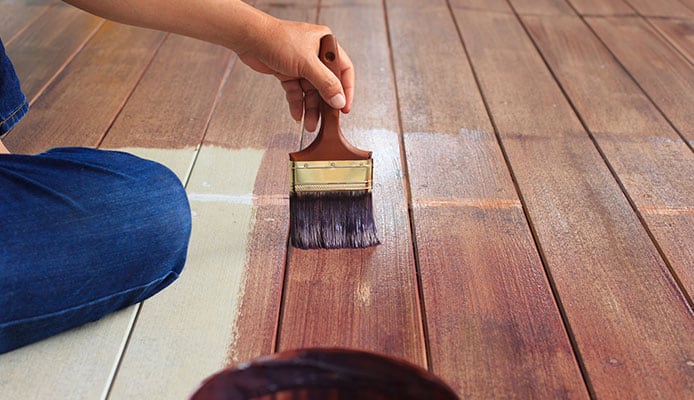
Best Boat Deck Paint Kit
KiwiGrip Non-Skid Deck System
Best large boat deck paint.
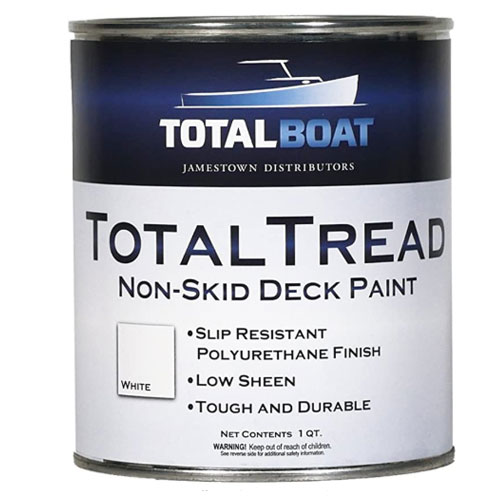
TotalBoat TotalTread Non-Skid
Best affordable boat deck paint.
Rust-Oleum Marine Topside
The top 6 boat deck paint in 2023.
- 1. KiwiGrip Non-Skid Deck System
- 2. TotalBoat TotalTread Non-Skid
- 3. Rust-Oleum Marine Topside
- 4. TUFF Coat UT-100 1 Gallon Non-Skid Coating
- 5. Durabak 18 Non-Slip Coating Deck Paint for Boats
- 6. Interlux Interdeck Slip-Resistant
If your boat deck started to fade and lose its grip, perhaps it’s time you repainted it and restored its former glory. More importantly, the best paint for the boat deck will also make your deck safer by adding a slip-resistant layer.
When choosing the right paint for your boat, you should think about a few things. The paint needs to be easy to apply, adhere well to the surface, resist weather conditions, and give you good traction whether it’s wet or dry.
In this article, we’re going to help you narrow down your choices. Our boat deck paint reviews will give you an insight into the best boat deck paints that will work fantastically on any deck surface. And, in the buying guide, you’ll learn about everything you should look for in high-quality paint.

Durable, eco-friendly, and easy to apply, Kiwi deck paint is one of the best all-around products that you’ll come across. It comes with a roller for faster application and, unlike most other products, even a single layer will provide good traction. Because of all this, it’s easy to see how the KiwiGrip paint got the top spot on the list.
With its water-based acrylic formula, KiwiGrip boat deck coating is great to work with. It comes as a one-party system, so you won’t have to mix anything. And, as we’ve mentioned, the formula is eco-friendly and contains no fillers, sand, or rubber flecks.
Application
To make your job easier, KiwiGrip includes a roller in the package that you can use to create both smooth and rough textures. A single layer will do a very decent job, and you’ll be able to cover about 20 square feet with a single liter. The material is spread out onto the deck and then the supplied roller “lifts” the top of it to create the perfect non-slip texture.
Performance and Looks
The performance is fantastic – it doesn’t slip and holds its own when exposed to saltwater and lots of sunlight. The KiwiGrip non-skid deck system is available in 5 stock colors and you can even add a tint if you want a custom one.
- Stand Out Features - Why We Love It
- KiwiGrip roller for easier application
- One-part system for convenient use
- Environmentally-friendly acrylic formula
- Adjustable texture (based on application technique)
Type: Water-based Acrylic Surfaces: Wood, Fiberglass, Epoxy, Concrete, Metal Volume: 1 or 4 liters Non-skid: Yes Coverage: 20 square feet per liter Curing time: 1h (touch), 24h (walk), 7 days (fully) Color(s): Black, Blue, Cream, Gray, White

Made using high-quality polyurethane, TotalBoat TotalTread marine deck paint promises excellent performance. It’s less abrasive than most similar products, adheres well, and doesn’t crack or peel in the sun, which is why we picked it as our favorite.
As we said, the formula is based on polyurethane that works equally well on fiberglass, wood, metal, and even previously painted surfaces. It’s even better in multiple layers, providing very reliable traction if you have two coatings.
The TotalTread boat floor paint is pre-mixed (easy to work with), and you can choose if you want to apply it with a brush or a roller. You’ll get detailed instructions on how to use it on different surfaces, and a single gallon can paint up to 300 square feet.
One of the best things about the TotalTread paint is its durability – it’s UV-resistant and perfectly safe to scrub without worrying about chipping or cracking. Lastly, you can get it in 4 basic colors that match most default deck colors.
- UV resistant formula won’t crack or peel in the sun
- Adheres well to almost any type of surface
- Easy to clean (safe for scrubbing)
- Large coverage with a single can
Type: Polyurethane Surfaces: Fiberglass, Wood, Metal, Previously Painted Surfaces Volume: 1 quart Non-skid: Yes Coverage: 250 to 300 square feet per gallon Curing time: 24h (walk), 2 weeks (fully) Color(s): Beige, Gray, Light Gray, White
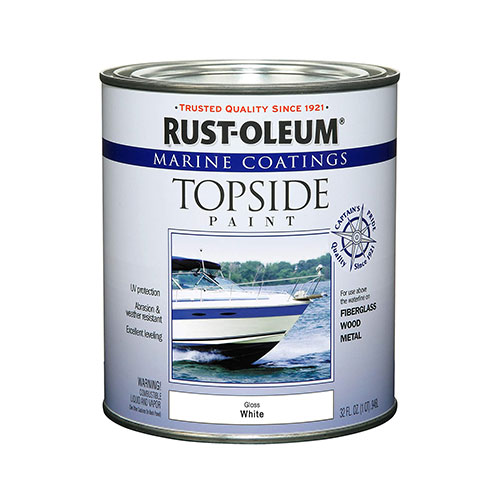
If you’re looking for an affordable way to make your deck look new, Rust-Oleum marine topside paint is a perfect choice. It’s smooth, easy to use, and works equally well on metal, wood, or fiberglass. Because of this, it easily gives you the best value for your money.
The formula is oil-based, unlike all the other deck paints featured on this list. While it’s maybe less durable in harsh conditions, it’s probably the easiest to use. On top of this, it looks beautiful and elegant, with a smooth finish and great gloss retention.
Due to its consistency, this sailboat deck paint can even be applied with a spray too (in addition to a brush). A single can cover up to 100 square feet, and the paint will be dry to the touch in an hour or two. It doesn’t contain any non-slip components, so this goes on the pretty parts of the deck that you want to make shine.
Made to the highest standards, Rust-Oleum fiberglass boat deck paint shields your deck from fading, abrasion, and any type of damage. You have 9 color options to choose from, so it’s easy to find the one you like.
- The oil-based formula for easier application
- Dries to the touch within 2 hours
- Retains gloss and color for a long time
- Abrasion-resistant with excellent durability
Type: Modified Alkyd Surfaces: Fiberglass, Wood, Metal Volume: 1 quart Non-skid: No Coverage: 100 square feet (per can) Curing time: 1 to 2 hours (touch) Color(s): 9 colors available
Best High Traction Boat Deck Paint
Tuff coat ut-100 1 gallon non-skid coating.
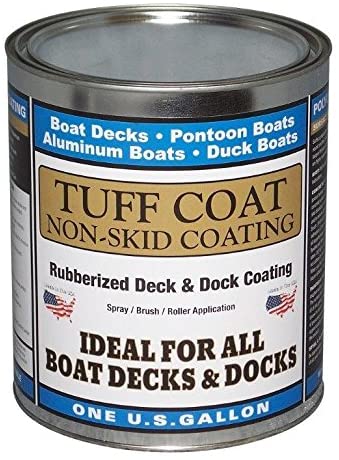
Thanks to its rubberized formula, TUFF Coat UT-100 deck paint gives you fantastic traction even on a completely wet deck. This non-skid paint for boats is tough, durable, and works great on decks, docks, and many other surfaces.
Tuff Coat pays a lot of attention to product safety, so this top-rated paint for the boat deck is completely non-hazardous. Like we’ve mentioned, it contains rubber particles that give it an edge over other products.
A detail we like about UT-100 paint is that you can apply it with a spray, brush, or a roller. It gives the best results when you apply two coats, and you’ll get about 45 square feet from one can.
The performance is impressive regardless of conditions – it won’t peel or crack regardless of the temperature or sun exposure. And, most importantly, it gives your feet a fantastic grip so you can move around freely.
- The rubberized formula prevents slipping
- Water-based and completely safe to use
- Highly resistant to UV rays and weather conditions
- Suitable for almost all types of surfaces
Type: Water-based Surfaces: Fiberglass, Concrete, Wood, Aluminum, Steel Volume: 1 gallon Non-skid: Yes Coverage: 40 to 45 square feet in two coats (per gallon) Curing time: 24h (touch), 5-7 days (fully) Color(s): 8 colors available
Best Boat Deck Paint For UV Protection
Durabak 18 non-slip coating deck paint for boats.
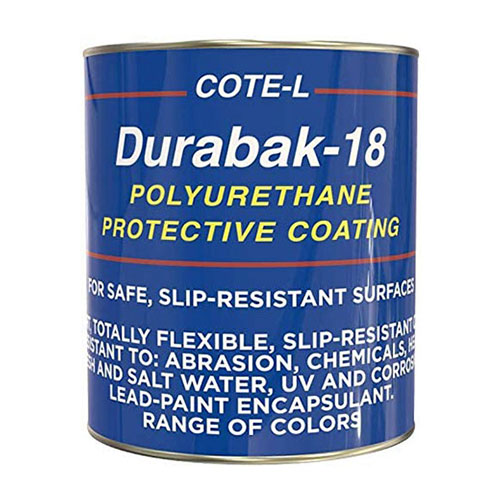
For ultimate deck customization, there’s no better choice than the Durabak non-slip deck paint. It’s available in sixteen great-looking colors that will make your deck look better than ever. The quality is on-point too, as it’s the paint of choice for many professionals and the US Navy.
Thanks to the recycled rubber tire granules, Durabak 18 guarantees impressive traction in both dry and wet conditions. The base is polyurethane that not only looks great but also provides great protection to the deck underneath.
You have three choices when applying the Durabak 18 paintbrush, spray, or the special Stipple Roller. The paint works well on fiberglass boats, concrete, wood, and metal, and even adheres well to itself (great for small reparations).
Durabak 18 paint is strong but flexible at the same time, so it maintains quality level over many years. Combine this with the numerous color options we mentioned, and you have a really solid choice when it’s time to repaint your boat.
- Textured for even greater slip-resistance
- A huge number of color options (sixteen)
- Suitable to use even in direct sunlight
- Bonds well to itself for easy reparations
Type: Polyurethane Surfaces: Concrete, Wood, Fiberglass, Metal, Coated Surfaces Volume: 1 gallon Non-skid: Yes Coverage: 60 square feet in two coats (per gallon) Color(s): 16 colors available
Best All Surface Boat Deck Paint
Interlux interdeck slip-resistant.
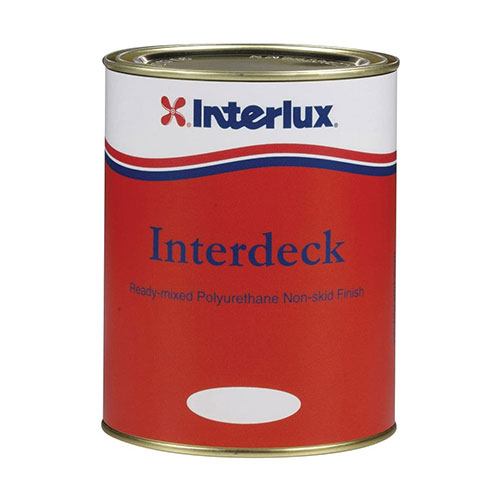
Versatility is the best thing about the Interlux Interdeck marine deck coating – it works equally well on all surfaces. On top of this, it doesn’t slip, prevents glare, and looks fantastic.
With an addition of a fine mineral additive that chemically bonds to the paint, Interlux non-skid deck paint has increased strength and durability. The base is polyurethane with all its well-known qualities (good adhesion and slip-prevention).
The texture of this paint is really fine, making the application much easier compared to most others. You can use it straight from the can (no mixing required), and all you need is a brush or a roller.
We particularly like that this is a low sheen paint, meaning that you won’t have any glare on the boat surface. Interlux Interdeck is available in 4 different colors, allowing you to give your deck the look you always wanted.
- Mineral additives significantly increase durability
- The low sheen finish helps prevent sunlight glare
- Looks great (no peels or cracks) for many years
- Great to use on any material, even painted surfaces
Type: Polyurethane Surfaces: Any Volume: 1 quart Non-skid: Yes Color(s): Gray, White, Cream, Sand Beige
How To Choose A Boat Deck Paint – Buying Guide
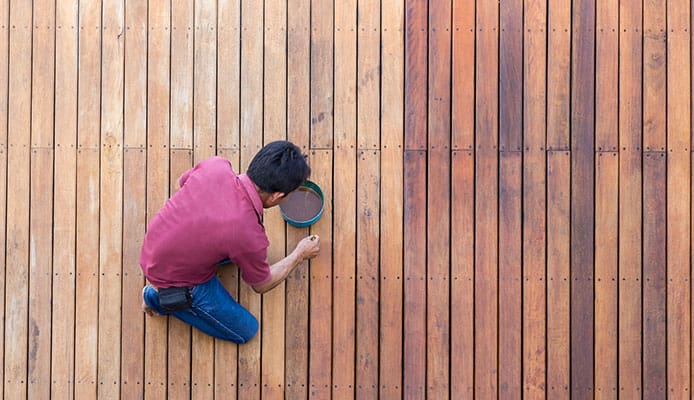
While it doesn’t have much to do with performance, color is very important for most of us. Simply put, we want the deck to look nice and blend in. As you’ve had the chance to see, most manufacturers offer paints in many beautiful colors so finding the one you like is easy. If you are deciding between a color and a white deck, ask yourself if you want to be able to walk barefoot on your boat. A white deck will stay cooler in the sun and not burn your feet like a dark deck on a hot day would. If you are planning on a color, also look into getting some really good boat shoes in our other list.
An important task for the paint is protecting the deck surface. This includes everything from foot traffic in your boat shoes to blocking out UV rays. With this in mind, look for tough but flexible paints that won’t peel or crack (especially if you’re not using a boat cover).
You might also like: Boat Polishes
Water Resistance
Since a boat deck comes into contact with a lot of water, the paint needs to be water-resistant. Regular paint would quickly wash away, so we advise that you always buy specialized paint that can withstand weather conditions.
Non-Slip Coating
Providing good traction when walking is the most important job of your non-skid deck paint. Furthermore, it will make using accessories like deck chairs more enjoyable too. Regarding slip resistance, two things play a role – paint formula and texture.
The painting process isn’t particularly enjoyable, and most boat owners don’t want to do it every year. Paying attention to the aspects we mentioned will guarantee that the paint will last for many years. Good paints are water and slip-resistant, don’t peel or crack, and look fantastic even after many years.
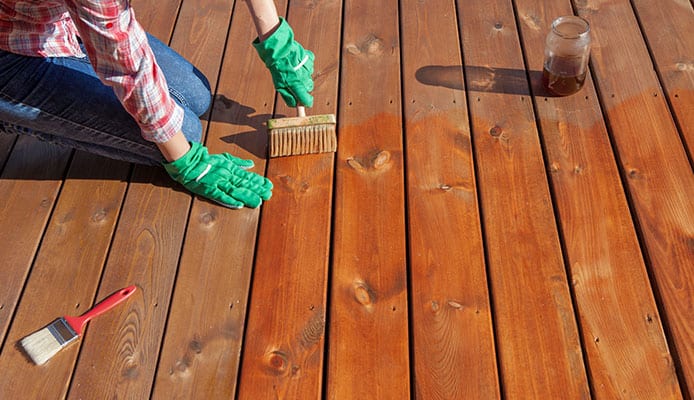
Q: How Should I Prepare My Boat Before Painting?
Before you paint, make sure to remove all the imperfections from the surface (chips and peels). Afterward, degrease and clean the surface and let it dry. Doing this will make your painting job easier and make the result much better.
Q: What Other Accessories Will I Need Besides The Paint?
While most paints we featured are a one-party system, some paints require a primer to improve adhesiveness. Of course, you’ll also need a brush or roller to apply the paint. Lastly, you can use a boat polish to give your vessel some shine once the paint dries.
Q: How Long Does It Take For The Paint To Dry?
The paint should be dry to touch in around 1-2 hours, depending on the type of climate that you are in. However, it’s probably the best idea to avoid walking over it for 24 hours so you don’t ruin the coating.
Q: Can I Paint Over Gelcoat?
Yes, you can paint over gelcoat. If it’s not completely covered with large cracks, you can get fantastic results. However, it requires a bit more preparation that includes a thorough cleaning, using epoxy primer, and sanding the surface.
Q: How To Paint Fiberglass Boat Decks?
Painting fiberglass boat decks is fairly easy if you follow a few simple guidelines. Here’s what you should do:
- Clean the deck (remove debris, rinse with fresh water, leave to dry)
- Apply masking tape (mark the area that you want to paint)
- Paint the deck area
- Leave to dry (up to 7 days before you return elements).
Globo Surf Overview
Painting the deck is an important part of boat maintenance , even though you won’t do it often. Not only does it make your boat look like new, but it also gives you secure footing so you don’t slip. With the boat deck paints from our list, you’ll get that extra safety and enjoy a great-looking deck each time you set out.
More Boating Detailing Reviews:
- Boat Buffers
- Boat Waxes
More Paint Reviews:
- Pool Deck Paint
Best Boat Deck Paint

December 22, 2022

Key Takeaways
- Boat deck paint is a vital component of boat maintenance. You safeguard not only your boat but also yourself. With the aid of paint, the boat surface is rendered non-slip and will appear as good as new.
- The boat deck gets damaged if not taken care of. Thankfully, applying deck paint can reduce the chances of wreckage. All you need to do is choose the best boat deck paint after weighing the pros and cons of each one of them.
- Make it a habit to clean the boat frequently. Letting the dirt accumulate deteriorates the paint. While cleaning the vessel, avoid using corrosive cleaners and use safe products.
You've probably heard of boat deck paints before, but did you know that there is an array of boat paints on the market?
The best boat deck paints are TuffCoat UT-100 Coating, TotalBoat TotalTread Deck Paint, and Rust-Oleum Marine Topside Paint. The deck is highly exposed to foot traffic and harsh weather, so good paint should offer a sturdy finish to protect it.
As a practical boat owner, I’ve used various of these paints for my DIY projects, and I can attest to the best boat deck paints. Besides my personal experience with these paints, I consulted with many boat owners and came up with the following list.
Table of contents
6 best boat deck paints.
Below are six boat deck paints, some indigenous and some proprietary, that have so far proved durable and retained a remarkable level of adhesiveness.
1. Tuff Coat UT-100 Coating

Paint Specifications
TuffCoat UT-100 coating features a single component, water-based non-skid coating that creates a long-lasting finish on the decks. This paint features among the best boat deck paints as it is non-submersible and aims to provide a durable, attractive, and impact-resistant surface for decks.
Tuff coat paint is available as a flexible matte finish. Therefore, dryness creates a thickness of 30-35 mils, which can hide significant imperfections on the deck surfaces. It also adds non-skid properties to provide additional safety.
Since the paint is made through a unique process of cross-linking acrylics, recycled rubber granules, urethanes, and co-polymers, it creates a long-lasting and non-slip finish.
Paint Performance
Tuff Coat is a single component, water-based coating and thus is fast drying. It is designed to provide highly durable, impact-resistant, non-slip surfaces. Due to its unique composition, this paint has a submersible medium texture, giving it a long-lasting finish.
What Sets this Paint Apart
- The paint is UV and chemical-resistant.
- Depending on the surface area, you can apply it by roller or spray.
- It is excellent for metal surfaces, fiberglass, and previously painted deck surfaces.
- It comes in varieties of colors (up to 15 colors).
- This paint is durable, water-based, and flexible.
Benefits of the TuffCoat Paint
- This paint has a single-ingredient formula, which means it does not require additional substances and can be used for all kinds of boat decks.
- Unlike other paints, Tuffcoat features a non-hazardous formulation.
- The deck surface is unlikely to peel as this paint leaves a rubberized texture which is highly durable.
Drawbacks of this Paint
Although the Tuffcoat paint features among the best, its major shortcoming is that you will require to use a primer undercoat.
2. TotalBoat Deck Paint

The TotalBoat TotalTread Paint is a unique, slip-resistant coating that is well known for creating durable high-traction surfaces. Due to its polyurethane's low-glare finish, this paint lasts longer as it creates a less abrasive surface.
This deck paint is resilient as it has its polyurethane resin readily mixed with unique texturing agents to achieve a slip-resistant surface. Additionally, its UV stabilizers allow its colors and finish to withstand harsh marine weather.
The TotalBoat deck paint features round Propyltex particles that enhance its grip and durability for a more abrasion-resistant surface.
You should use two coats of paint to get the best combination of durability and grip. You can, however, opt for the High-solids Total Tread deck paint that covers the deck in the coat. This paint is less abrasive and hence easy to clean.
This paint is slip-resistant. Therefore, it comes in handy when used in areas where extra traction is needed. Applying this paint using a brush or a roller is easy. One gallon of paint is likely to cover 250-300sq.
- TotalBoat deck paint features a unique formula that creates a high-traction, comfortable, and durable deck surface.
- This paint is versatile and can be applied to other parts of the boat.
- Its UV-stable formula offers a long-lasting finish that is not likely to peel, fade, or crack.
- It is easy to apply.
Benefits of the TotalBoat Total Tread Non-Skid Deck Paint
- This paint offers an economical way to get an attractive and low-glare surface.
- The paint's rubbery texture is ideal for maximum traction, and unlike most non-skid paints, TotalBoat is not prone to abrasion.
- Through its non-skid properties, this paint reduces slip and fall accidents and lowers the possibility of wear and tear.
- Its wax texturing agents allow gloss control.
Drawbacks of the TotalBoat Total Tread Non-Skid Deck Paint
The major drawback of the TotalBoat deck paint is that you require two coatings because more coatings enhance the grip. Additionally, your mixing skills should be top-notch to achieve the desirable results.
3. Rust-Oleum Paint

Rust-Oleum Marine Paint is designed to provide gloss retention, UV resistance, and durability in extreme weather conditions and other elements. The paint has an oil-based formula which makes it flexible and easily applicable.
Boats are huge investments, and taking ultimate care of these vessels is crucial. Rust-Oleum Topside paint offers maximum performance that prevents everyday wear and tear, keeping your boat stylish.
This paint creates a durable coating that resists abrasion and extreme weather conditions. The layer is ideal as its durability is unmatched. Additionally, it offers long-term UV protection.
Another desirable feature of the Rust-Oleum Topside Paint is its superior gloss retention. The excellent gloss retention and smooth finish maintain the aesthetics and elegance of your boat's surfaces.
This varnish is created to expand and contract with varying temperatures. This feature enables it to resist common damaging elements. This paint is made from a modified alkyd, which makes it highly durable.
- Rust-Oleum Topside Paint slowly releases copper for superior fouling protection. This highly deters marine growth build-up.
- It has a fine ground pumice base that can mix with any latex or oil-based paints for ultimate grip.
- This paint has brilliant colors that can withstand extreme weather conditions.
- This paint is capable of covering a vast surface, and it dries up fast.
The benefit of the Rust-Oleum Marine Topside Paint
- It protects the deck from UV damage.
- It is salt, moisture, and mildew resistant.
- It adds an anti-slip grip which enhances safety.
- The paint protects the deck from corrosion.
- It offers exceptional gloss retention properties that resist fading and cracking.
- One can use it for various surfaces of the boat.
- It provides a brilliant finish and long-lasting protection.
Drawbacks of the Rust-Oleum Marine Topside Paint
The Rust-Oleum Marine paint is loved for its potentiality and performance. However, since this paint has an oil-based formulation, it tends to create a mess and is pretty hard to clean up.
The irking fumes produced by this paint are pretty irritating.
4. KiwiGrip Non-Skid Deck System

KiwiGrip Non-Skid Deck System is a durable, non-skid coating that is simple to apply and creates a customizable texture. This paint spreads quickly through the deck area, offering an excellent, high traction surface.
This paint is a homogeneous material; therefore, it does not require fillers like sand, beads, rubber fleck, or walnut shells. For ultimate protection, this paint is loaded with a UV stabilizer. Alternatively, it features among the best boat deck colors for its low glare, even under the sun.
One liter of KiwiGrip can cover a surface of about 20 square feet. The paint is easy to apply, and the package includes a proprietary roller ideal for creating a high traction surface.
The KiwiGrip paint has varying application techniques depending on your preferable texture. You can change the surface from a rolled pleasure boat texture to an industrial aggressive work boat texture.
Unlike two-part anti-slip deck coatings, KiwiGrip is applied using a brush which is considerably faster and easier. With this paint, repairs are invisible. This paint also features a thick consistency which dries up equally fast.
- KiwiGrip is easy to maintain as its homogeneous material does not tend to wear through fillers. This paint's texture is achieved through the roller and not the stuffing.
- It is available in five colors, with UV stabilizers and low glare features.
- You can apply this paint through various application techniques.
- You can use it in many applications, such as wood, fiberglass, epoxy, concrete, and metal.
- KiwiGrip paint is easily tinted to come up with custom pastel colors.
Benefits of the KiwiGrip Non-Skid Deck System
- It is a revolutionary coating that is highly durable.
- This coating is easy to clean and recoat. The good thing about this coating is that its repairs are invisible.
- The paint’s application techniques are adjustable.
- KiwiGrip is a water-based acrylic, and therefore it is environmentally friendly.
- This paint altogether lowers the finished cost of application hence saving money.
- One single coat of this coating is enough for the deck surface.
Drawbacks of the KiwiGrip Non-Skid Deck System
This coating feature's only shortcoming is that it requires gradual application since it dries too fast.
5. Interlux Interdeck Deck Paint

Interlux Interdeck Deck Paint is a slip-resistant deck paint suitable because it contains good mineral additives for hard-wearing and non-slip surfaces. This paint includes fine aggregates that make it easily applicable to all substrates.
This paint has a tough polyurethane resin that provides a high-quality slip-resistant finish. Interlux has a low-sheen finish that reduces the sun's glare and wears and tear.
You need to apply a minimum of two coats to attain a desirable outcome. This paint requires a few days to cure before you expose it to the marine environment. When applied correctly, this paint guarantees a long-lasting effect.
The solid polyurethane resin aggregated in this paint ensures maximum protection against wear and tear. Fundamentally, this paint offers a long-run solution for slippery decks.
- Interlux deck paint features a slip-proof characteristic that is appropriate for all substrates.
- The paint comes with acceptable mineral additives to increase its non-slip capabilities.
- It protects the deck from UV rays.
Benefits of the Interlux Interdeck Slip-Resistant Deck Paint
- The low sheen finish of this paint prevents the sunlight glare.
- It comes in a variety of colors.
- It contains fine aggregates that enable it to spread quickly over any surface.
- This paint is not cumbersome to use.
Drawbacks of the Interlux Interdeck Slip-Resistant Deck Paint
This paint needs a minimum of two coats to attain a desirable outcome. Again, this paint takes quite a long time to cure.
6. Evercoat Coating

The Evercoat Coating is an innovative paint that performs to achieve top-notch results. This deck paint is texturized with a non-skid formulation that contains acrylic latex and ground rubber.
You can apply Skid-No-More paint to fiberglass, wood, metal, or concrete. This non-skid coating features non-abrasive, elastic, and resilient properties. It can be applied to deck surfaces using a paintbrush, a roller, or a squeegee.
This paint is ideal for creating a texturized, skid-resistant, acrylic latex coating for boat decks. It offers an excellent alternative for non-skit tapes. Evercoat paint provides a controlled release of latex to excellent anti-skid properties.
- You can apply it to a wide range of surfaces.
- It gives an even paint distribution.
- This paint is a certified A1 acrylic rubberized non-coating.
Benefits of the Evercoat Skid-No-More Rubberized Non-Skid Coating
- This paint achieves an ergonomic grip.
- It's an excellent option for its even distribution.
- It offers an acrylic rubberized coating that protects the deck from harsh weather elements.
- It can be tinted using color agents.
Drawbacks of the Evercoat Skid-No-More Rubberized Non-Skid Coating
This paint can be a bit messy during application. However, there is no cause for alarm as it is easy to clean.
Another drawback is that this paint does not last long as expected. It deteriorates quickly.
Factors to Consider When Buying Boat Deck Paints
As stated earlier, boats are enormous investments that require premium maintenance. Lately, finding the best boat deck paint could be a cumbersome process as numerous brands in the market are claiming to be the best picks.
Fortunately, there are features to look out for and factors to consider to get the ideal deck paint. Below are factors to consider for a wise product investment regarding boat deck paints.
The boat deck undergoes significant exposure to foot traffic, UV rays, and extreme weather conditions. Whatever deck paint you choose should be tough enough to withstand the above elements.
Suitable deck paints create a durable finish, and protecting the deck is their ultimate goal. Additionally, the paint should not deteriorate quickly. It should be long-lasting.
Apart from offering protection to the deck, deck paints are crucial in guaranteeing safety to the boaters. Always ensure that you get boat deck paints that are slip-resistant. Alternatively, boat deck paints should protect the decks and surfaces from cracking, peeling, and fading.
To ensure ultimate protection, go for paints with desirable formulas and textures. The right deck paint also guarantees comfort. The paints fill up cracks and gaps that are present in the deck.
Paints repel UV rays damage, molds, rusting and rotting in wooden boats. For boaters who love cleaning their vessels from time to time, paint eases the job. This is because excellent finishes require effortless cleaning.
Color plays a significant role in the aesthetic enhancement of the boat deck. Deck paints are available in many colors, and you can choose one that suits your deck. Choose colors that are easily replaceable whenever they fade.
It is important to note that dark colors on the deck readily absorb heat. Therefore, you will be required to wear shoes on board. On the contrary, a white-colored deck remains cool even under the sun. You can thus enjoy the freedom of being barefoot onboard.
This article may contain affiliate links where we earn a commission from qualifying purchases. The images and content on this page may be created by, or with the assistance of, artificial intelligence, and should be used for entertainment and informational purposes only.
About THE AUTHOR
Brian Samson
I have a deep love of houseboating and the life-changing experiences houseboating has brought into my life. I’ve been going to Lake Powell on our family’s houseboat for over 30 years and have made many great memories, first as a child and now as a parent. My family has a passion for helping others have similar fun, safe experiences on their houseboat.
Trending Now
After spending over 30 years on houseboats, the memories and knowledge we've gained will never fade. Learn from our experiences here on LakeWizard. You can read more about us and our team, here .
©2024 LakeWizard. All rights reserved.
You can email us at [email protected]
LakeWizard.com is a participant in the Amazon Services LLC Associates Program, an affiliate advertising program designed to provide a means for sites to earn advertising fees by advertising and linking to Amazon. This site also participates in other affiliate programs including but not limited to ShareASale, CJ, and ClickBank, and is compensated for referring traffic and business to these companies.

- Sports & Outdoors
- Boating & Sailing
- Maintenance Supplies
- Painting Supplies
Image Unavailable

- To view this video download Flash Player

TotalBoat TotalTread Non-Skid Deck Paint, Marine-Grade Anti-Slip Traction Coating for Boats, Wood, Fiberglass, Aluminum, and Metals
| Brand | TotalBoat |
| Color | Sand Beige, Kingston Gray, Light Gray, White |
| Finish Type | Matte |
| Special Feature | Non Toxic |
| Paint Type | Acrylic |
| Specific Uses For Product | Boat decks, docks, stairs, steps, gunwales, swim platforms, concrete, patios, and floors |
| Surface Recommendation | Floors |
| Item Form | Stick |
| Included Components | Paint |
| Age Range (Description) | Adult |
About this item
- NON-SKID DECK PAINT: Durable, textured, low-glare high-traction surface for secure footing, with a comfortable rubberized texture that's less abrasive than traditional silica additives
- LONG-LASTING POLYURETHANE FINISH: Durable coating won't fade or peel; easy to clean - scrubbing won't wear away the finish; affordable way to bring your old boat flooring back to life
- NON-SLIP PAINT WITH MANY APPLICATIONS: Boat decks, docks, cabin soles, hatches, stairs, steps, gunwales, swim platforms, concrete, patios, floors, and anywhere else you need sure footing
- 1-PART PAINT IS EASY TO APPLY by brush or roller on fiberglass, wood, properly primed aluminum, metals, and previously painted surfaces; add a second coat for greater traction. Coverage: 250-300 sq. ft. per gallon
- COMES IN PAINT COLORS TO MATCH TOPSIDES OR EXISTING NON SKID PATTERNS: Sand Beige, Kingston Gray, Light Gray, White (tintable with TotalBoat Wet Edge Topside Paint). Available in Quarts and Gallons
Additional Details

Similar items that ship from close to you

Product Description

Tough Coating Protects the Deck. Non-Skid Additive Protects Your Crew.
TotalBoat TotalTread Non-Skid Paint creates an attractive, long-lasting non-slip surface for safe footing on boat decks, docks, ramps, & steps.

TotalBoat TotalTread Non-Skid Deck Paint is the Easy, Economical Way to Get an Attractive, High-Traction, Low-Glare Surface that Actually Feels Good Underfoot.
This one-component, slip-resistant, marine-grade paint is easy to apply to fiberglass and wood decks, for maximum traction and reduced sun glare..
The safety of all passengers & crew is always a top priority because boat decks are awash in all kinds of things that make them slippery and unsafe—rain, dew, spray, liberal use of the washdown hose, & spilled drinks, for example. Decks also bear the brunt of heavy foot traffic & punishing sun. TotalBoat TotalTread Non-Skid Paint makes it easy to prevent daily wear & tear from ruining your deck—and slip & fall injuries from ruining your day. Its 1-component polyurethane formula is mixed with unique Propyltex wax texturing agents that form a better bond to the paint than other brands. Just stir thoroughly, then apply with a brush or roller. TotalTread's rubbery texture provides maximum traction, & isn't abrasive like the silica-based additives in most non-skid paints. It feels good on bare feet and won't scrape the skin off of kneeling knees. A little hard scrubbing with a stiff bristle brush cleans the surface—without particles becoming dislodged or dark specs showing through.
More coats equals more grip.
TotalTread is ideal for boat decks, docks, ramps, steps, gangways, cabin soles, cabin tops, anchor locker covers, and much more. It comes in colors that match our TotalBoat Wet Edge Topside Paint & its high-solids formula will cover completely in one coat. However, to get the best combination of grip and durability, we recommend applying two coats. For a more aggressive grip, apply a third coat.
Frequently Asked Questions about TotalBoat TotalTread Non-Skid Deck Paint
Q: How many coats should be applied?
A: TotalTread will cover completely in one coat. However, we recommend two coats, for maximum grip and durability. For more texture, apply a third coat.
Q: What is the dry time for TotalTread before use?
A: For maximum anti-wear characteristics, let TotalTread cure for 48 hours.
Q: Is cured TotalTread waterproof?
A: Yes, cured TotalTread is waterproof.
TotalBoat TotalTread Non-Skid Paint Features
- Compare to Interlux Interdeck, Evercoat Skid No More, Kiwigrip & Pettit EZ Bilge
- TotalTread is not abrasive, has better grip, finish retention, shock absorption & cleans up easier
- One-part, pre-mixed formula ensures easy DIY application using a brush or roller
- Wax texturing agents allow maximum traction & gloss control
- The more coats you apply, the greater the grip
- Apply to properly prepared fiberglass, wood & previously painted surfaces in good condition
- Colors: White, Gray (Kingston Gray), Sand Beige (these match TotalBoat Wet Edge colors), Light Gray
- Sizes: All colors available in Quarts and Gallons
TotalBoat TotalTread is Very Easy to Apply, and Looks Great!
| FIBERGLASS . . WOOD . . PREVIOUSLY PAINTED SURFACES . . METALS
| MIXING The non-skid particles in TotalTread have a low density so they remain suspended in the paint, without floating to the top, or sinking to the bottom, like other non-skid paints. Mixing is easy and quick, just use the supplied mixing sticks and stir thoroughly. During application, you don’t need to keep stirring in order to keep the particles suspended in the paint. APPLICATION , if needed. TIP: Thin, even coats will yield the best results. TINTING TOTALTREAD To get a desired color, without ruining its high-traction finish properties, TotalBoat TotalTread can be tinted, up to 10% by volume, with TotalBoat Wet Edge Topside Paint. TIP: It's very important not to add too much tint, or you'll ruin the non-skid properties of TotalTread. | When sanding between coats, some of the grit will get sanded down, but do not sand completely smooth. | TotalTread color shown: Sand Beige |
| Customer Reviews | |||||
|---|---|---|---|---|---|
| Primary Uses for TotalBoat Topside Paints | Provides a non-slip surface on decks, docks, ramps, steps, walkways, gangways, cabin soles, & other topside surfaces. | Provides a beautiful, high-gloss, finish with maximum abrasion resistance on hulls and other topside surfaces. | Provides a beautiful, high-gloss, finish with maximum abrasion resistance on hulls and other topside surfaces. Can be applied in temperatures as low as 45°F. | Provides a durable, corrosion-resistant, low-sheen finish on aluminum and galvanized metal boats. No priming necessary. Ideal for aluminum duck boats, bass boats, canoes, jon boats, layout boats, dinghies, & pontoon boats. | Provides a durable, high-gloss protective coating for bilges, bulkeads, and locker areas. Epoxy-based formula protects against solvent damage. |
| Usage | Exterior, above the waterline | Exterior, above the waterline. Not designed for continuous submersion on boat bottoms that remain in the water longer than 72 hours. | Exterior, above the waterline. Not designed for continuous submersion on boat bottoms that remain in the water longer than 72 hours. | Exterior, above or below the waterline. | Interior |
| Substrates | Fiberglass, wood, and previously painted surfaces in good condition, and properly prepped and primed metals. | Wood, fiberglass, and previously painted surfaces in good condition. Can be applied to aluminum and steel substrates if prepped & primed properly. | Wood, fiberglass, and previously painted surfaces in good condition. Can be applied to aluminum and steel substrates if prepped & primed properly. | Aluminum, galvanized metal. | Wood, fiberglass, and previously painted surfaces in good condition. |
| Application Temperature / RH | 50°F to 90°F / 0-90% | 50°F to 90°F / 0-90% | 45°F to 70°F / 0-90% (do not use within 5° of the dew point). | 50-90°F | 50°F to 90°F / 0-90% |
| Application Method | Brush or roller | Brush, roll and tip, or spray | Brush, roll and tip, or spray | Brush, roll, or spray | Brush, roll, or spray |
| Finish | Flat, textured | High gloss, smooth (flat finish available in White, Black, and Gray) | High gloss | Low sheen, non-reflective | High gloss, smooth |
| Thinner/Reducer | TotalBoat Special Brushing Thinner 100, 5-10%, if needed | Brush/roll – TotalBoat Special Brushing Thinner 100, 5-10%; Spray – xylene, 15-20% | Brush/roll – TotalBoat Special Brushing Thinner 100, 5-10%; Spray – xylene, 15-20% | Water, up to 20% maximum. | Brush/roll application - If needed, TotalBoat Special Brushing Thinner 100; Spray application - thin with xylene |
| Cleanup | TotalBoat Special Brushing Thinner 100 or TotalBoat Dewaxer & Surface Prep | TotalBoat Special Brushing Thinner 100 or TotalBoat Dewaxer & Surface Prep | TotalBoat Special Brushing Thinner 100 or TotalBoat Dewaxer & Surface Prep | Clean up with soap and water before Aluminum Boat Paint cures. | TotalBoat Special Brushing Thinner 100, xylene, or TotalBoat Dewaxer & Surface Prep |
| Coverage | 250-300 sq. ft./gal. | 250-300 sq. ft./gal. | 80-100 sq. ft./qt. | 80-100 sq. ft./qt. | 80-100 sq. ft./qt. or 250-300 sq. ft./gal. |
| Sizes / Colors (*All colors not available in all sizes) | Quart, Gallon / Sand Beige, White, Gray. NOTE: These colors match TotalBoat Wet Edge Topside Paint colors Sand Beige, White, and Kingston Gray. NEW COLOR! Light Gray (lighter and less 'blue' in tone than Kingston Gray). | *Pint, Qt, *Gal. / Aqua Mist, Black, Blue-Glo White, Classic Whaler Blue, Bristol Beige, Sand Beige, Fighting Lady Yellow, Fire Red, Flag Blue, Hatteras Off-White; Kingston Gray, Largo Blue, Off-White, Oyster White, Sea Foam, Sea Green, White, Yellow | Quart / White, Oyster White, Flag Blue, Sea Foam, Sea Green, Fire Red | Quart / Army Green, Earth Brown, Khaki, Black, Light Gray, White | Quart, Gallon / Gray, White |

It all started simply enough. As boaters, we wanted better stuff for our own boats.
Even our favorite products, the ones we'd come to rely on, had room for improvement. It'd be nice if they could hold up longer, cure faster, coat better, apply easier, and—since we all know boat ownership creates a mini maelstrom in your pocket—cost less. So we took everything we knew from 35 years of customer feedback, combined that with our own boating knowledge, and after a few years of rigorous R&D, TotalBoat was born. Launched, rather. By boaters, for boaters.
Need help? Our TotalBoat Tech Team is a bunch of boat owners who really know their stuff. So whether you're trying to figure out what to buy or what's the best solution for your particular project, they have years of hands-on training and experience—and a passion to help you succeed.
Product information
Technical details.
| Brand | TotalBoat |
|---|---|
| Color | Sand Beige, Kingston Gray, Light Gray, White |
| Finish Type | Matte |
| Special Feature | Non Toxic |
| Paint Type | Acrylic |
| Specific Uses For Product | Boat decks, docks, stairs, steps, gunwales, swim platforms, concrete, patios, and floors |
| Surface Recommendation | Floors |
| Item Form | Stick |
| Included Components | Paint |
| Age Range (Description) | Adult |
| Is Waterproof | True |
| Package Information | Can |
| Coverage | 250-300 square feet per gallon |
| Water Resistance Level | Water Resistant |
| Manufacturer | TotalBoat |
| Is Discontinued By Manufacturer | No |
| Finish | Matte |
| Item Package Quantity | 1 |
| Special Features | Non Toxic |
| Batteries Included? | No |
| Batteries Required? | No |
Additional Information
| ASIN | B00J32JYMG |
|---|---|
| Customer Reviews | 3.0 out of 5 stars |
| Date First Available | March 21, 2016 |
Warranty & Support
Videos for this product

Click to play video

TotalBoat TotalTread Non-Skid Deck Paint
Atlantic Boat Supply
Looking for specific info?
Top brand: totalboat, compare with similar items.
| Price | Currently unavailable. | $47.48$47.48 | $109.99$109.99 | -7% $36.28$36.28 List: $38.99 |
| Delivery | — | |||
| Customer Ratings | 4 | 781 | 138 | 17 |
| Sold By | ||||
| volume | ||||
| unit count | ||||
| paint type | ||||
| surface suggestion | ||||
| waterproof |
Customer reviews
- 5 star 4 star 3 star 2 star 1 star 5 star 51% 0% 0% 0% 49% 51%
- 5 star 4 star 3 star 2 star 1 star 4 star 51% 0% 0% 0% 49% 0%
- 5 star 4 star 3 star 2 star 1 star 3 star 51% 0% 0% 0% 49% 0%
- 5 star 4 star 3 star 2 star 1 star 2 star 51% 0% 0% 0% 49% 0%
- 5 star 4 star 3 star 2 star 1 star 1 star 51% 0% 0% 0% 49% 49%
Customer Reviews, including Product Star Ratings help customers to learn more about the product and decide whether it is the right product for them.
To calculate the overall star rating and percentage breakdown by star, we don’t use a simple average. Instead, our system considers things like how recent a review is and if the reviewer bought the item on Amazon. It also analyzed reviews to verify trustworthiness.
- Sort reviews by Top reviews Most recent Top reviews
Top reviews from the United States
There was a problem filtering reviews right now. please try again later..
- Amazon Newsletter
- About Amazon
- Accessibility
- Sustainability
- Press Center
- Investor Relations
- Amazon Devices
- Amazon Science
- Sell on Amazon
- Sell apps on Amazon
- Supply to Amazon
- Protect & Build Your Brand
- Become an Affiliate
- Become a Delivery Driver
- Start a Package Delivery Business
- Advertise Your Products
- Self-Publish with Us
- Become an Amazon Hub Partner
- › See More Ways to Make Money
- Amazon Visa
- Amazon Store Card
- Amazon Secured Card
- Amazon Business Card
- Shop with Points
- Credit Card Marketplace
- Reload Your Balance
- Amazon Currency Converter
- Your Account
- Your Orders
- Shipping Rates & Policies
- Amazon Prime
- Returns & Replacements
- Manage Your Content and Devices
- Recalls and Product Safety Alerts
- Registry & Gift List
- Conditions of Use
- Privacy Notice
- Consumer Health Data Privacy Disclosure
- Your Ads Privacy Choices
5 Reasons Why You Should Never Paint Your Deck, Pros Say
:max_bytes(150000):strip_icc():format(webp)/SLnew121-ef06bf9477ec4706b5a8c1440544bda3.jpg)
PhanuwatNandee / Getty Images
If you're considering painting your deck, be mindful that experts are extremely opposed to this practice for a number of reasons.
Below, they delve into the risks associated with painting a deck, which include the presence of moisture, the fact that painted, high-traffic flooring can be difficult to maintain, and more, as detailed below.
Decks Retain Moisture
Many experts note that because a deck will retain moisture, it is not compatible with paint.
"Unlike the walls of your home, a deck lays flat horizontally, meaning it is easier for water to pool on your deck," Kelly Mardis , the owner of Marcel Painting. "Prolonged exposure to pooled water will cause the paint on your deck to crack over time."
Paint is likely to peel on a wood surface such as a deck, Doug Greene , owner and operator at Signature Properties, explains. Whether it's spruce, cedar, pine, or Douglas fir, Greene explains how they chip or bubble over time when it's applied on exterior applications like a deck.
Want more home reno project tips and inspiration? Sign up for our free daily newsletter for the latest how-tos, reno guides, and more!
Paint Is High Maintenance
Painting your deck is going to take time and effort, and unfortunately, your hard work may quickly go unnoticed due to the normal wear and tear that any deck experiences. Unless you want to constantly be touching up your deck, you are better off leaving it unpainted, pros say.
Sallie Lord , the founder of GreyHunt Interiors, explains how although it may initially look amazing, it will begin to show scuffs and its fresh crispness after a year.
Mardis agrees and explains how you will use your deck often which can lead to people walking on it, guests dropping food, and outdoor furniture scraping it. It may be worth skipping the paint so you don't have to worry too much about touching it up. Even if your deck is in absolutely pristine condition at all times, paint isn't foolproof—it fades, too.
Painted Surfaces Are Slippery
Paint makes a surface more likely to become slippery when wet, so to ensure you are easily able to maneuver about the space, you are better off skipping the paint entirely.
"This can pose a safety hazard, particularly for decks that are often exposed to rain, morning dew, or humidity," Allison Kaminski , the lead designer at Lola Tucker Interiors, says. Instead of thoroughly enjoying your deck, you might find yourself constantly worrying about slipping, Kaminski says.
Paint Gets Hot
In addition to becoming slippery, paint also heats up depending on the color or enamel, which may make spending time out on the deck not so pleasant. Especially if you live in a warmer area and love spending time outdoors, it may be difficult to enjoy your time if your paint is on the darker side.
"This makes a quick trip across it with your bare feet intolerable," Greene says.
Staining a Deck Takes Just as Much Effort
As discussed above, painting a deck is no easy task, and you are better off redirecting your effort to staining your deck , which is a much more viable solution,
"Stains are much more reliable because they penetrate the wood to seal it, versus just sitting on the surface," Greene says. "This penetration means no layers that could peel or bubble up over time."
Plus, he adds, the cost to stain your deck is similar to the cost of painting it. Greene explains how paint could actually be seen as more of an expensive undertaking.
"Paint is just an investment—once you paint, you must repaint and repaint," he says. "Think about it long and hard before you reach for the can of paint because it might turn into an annual painting of the deck."
Staining your deck, on the other hand, will last for three to five years. Jay Sanders , the owner of Castle Dream Construction & Basement Waterproofing, says. Sanders recommends using a stain with UV protection, so it doesn't fade easily. A stain will also help enhance the overall look of the wood, so maintenance will be easier and much more practical to take care of.
More from The Spruce

IMAGES
VIDEO
COMMENTS
Steps:**. 1. In preparation for the job, much of the deck hardware, including the stanchions, had to be removed. The remaining gear was carefully and completely covered and masked. 2. All the fastener holes were filled with silicon sealant, and the couple spent days grinding the old surfaces.
KILZ Over Armor Textured. 11. INSL-X SU031009A-01 Sure Step Coating. 12. Evercoat 853 Skid-No-More Rubberized Coating. Factors To Consider When Choosing Boat Deck Paint. What Is The Best Boat Deck Paint. How Should I Prepare My Boat Before Painting. How Do You Paint A Fiberglass Boat Deck.
11 Apple Ln , Southwest Harbor ME 04679-4424. home. categories. boat maintenance. boat paint & solvents. non-skid deck paint. Part of the fun of being on a boat is feeling the sea (or maybe your favorite lake or river) under your feet. The rise of the bow as we travel up and over a wave or the inclination of a sailboat's deck while on a broad ...
Z Spar recommends using a 4-ounce (by weight) can to 1 quart of paint. One-pound cans of #M-612 Non Skid Compound, for use with 1-gallon paint containers, also are available. Priced at $10.99/4 ounces, the Z Spar product is expensive compared to the Interlux product at $19.95/quart. Pettit Skidless Compound.
First, carefully prepare the surface, and when applying an LPU paint by roller and brush, remember "less is best.". A slower reducer allows the paint to flow and makes brush and roller marks disappear. Multiple light coats with scuff sanding in between works best. Your Alden has a certain market value based upon a specific level of fit and ...
Use 220- to 300-grit sandpaper. Step 2: Wipe down with solvent to remove grease and dirt. For Interdeck, use 2333N solvent. Step 3: Open the can and mix the paint well. If you wish to make the deck more nonslip, you can sprinkle Interlux's InterGrip onto the wet-paint layer or add it to the can of paint.
Best Boat Deck Paints (New List 2021) So, check out the paints that we have selected, but don't assume that No. 1 may automatically be the best one. 1. TotalBoat Non-Skid Deck Paint. Thanks to being one part polyurethane, this paint makes the surface it covers durable and non-slippery.
3. Paint at optimum times of day. If you're outside, paint in mid to late morning after the dew has evaporated, and in mid-afternoon. Avoid noontime when the sun is overhead and at its hottest, and late afternoon, when evening cooling and moisture can affect drying time and finish. 4.
Go with Kiwi Grip. It's overall the best non-skid deck paint for your boat, and as long as you plan well, you can do a whole boat, including the cockpit, in about three sessions. But be warned, it's expensive stuff. It costs around 150$ per gallon (4 Liters), and each gallon can of KiwiGrip can cover about 80 square feet.
Interlux now offers three solutions for refinishing a non-skid deck: Stir and apply Interdeck - a pre-mixed, slip resistant, single component, ready to use deck paint that can be applied over Prekote primer or Epoxy Primekote primer 404/414. Mix your own non-skid finish: any one of the Perfection or Brightside Polyurethane finishes can be ...
Paper mask-off the area you want to protect. Lightly roughen the exposed areas with 280 grade paper. Apply one coat of topcoat as per label instructions. Using one of the methods described above, apply the powder material while the topcoat is still very wet. Allow the coat of paint to dry for the appropriate period.
Wash with standard, mild boat soaps (PS, January 2013) or household cleaners and a soft- to medium-bristled brush. Steer clear of bleach and other chlorinated or acid-based cleaners as they can affect the paints color pigments and UV inhibitors. Be sure to rinse the decks well with fresh water, when possible.
Why Non-Skid Deck Paint is Essential. Safety on boats is crucial, particularly on decks where water creates slipping hazards. Whether for recreational purposes or professional boating, non-skid surfaces are essential to prevent accidents and ensure stability. Non-skid deck paint offers a practical solution that enhances traction and improves ...
This non-slip boat deck paint is ideal for aluminum boats, fiberglass boats, duck boats, and more. 7. Tuff Coat UT-211 Light Gray Non-Skid Coating. It's unquestionably marine-grade paint because of the finish that it makes. It has a non-skid additive in the form of recycled rubber tire granules.
Clean the work area. Use Boat Cleaner to ensure the deck is as clean as possible before applying any paint. Vacuum up any dust or small pieces of debris on the deck, and also clean any sticky residue that may be present with Release Adhesive & Sealant Remover. Be sure to let the deck dry thoroughly before the painting process begins.
NON-SLIP PAINT WITH MANY APPLICATIONS: Boat decks, docks, cabin soles, hatches, stairs, steps, gunwales, swim platforms, concrete, patios, floors, and anywhere else you need sure footing 1-PART PAINT IS EASY TO APPLY by brush or roller on fiberglass, wood, properly primed aluminum, metals, and previously painted surfaces; add a second coat for ...
SKU: 409326. Unique non-skid slip resistant marine deck paint creates a high-traction surface that's less abrasive and more durable compared to traditional silica additives. This one-part polyurethane's low-glare finish lasts longer and looks better than what you've been using. Ideal for use on boat decks, docks, ramps, steps and more.
Interdeck slip-resistant deck paint produces an excellent slip-resistant finish with a tough polyurethane resin that protects decks against everyday wear and tear. It contains a fine aggregate and applies easily to all to all substrates. Interdeck has a low-sheen finish to reduce sun glare. Available in White, Cream, Beige, Gray and Blue.
How to paint boat deck.How i improved the look and condition of my boat deck. better than new gelcoat DIY deck paintPainting my boat deck and cabin with Pe...
4. TUFF Coat UT-100 1 Gallon Non-Skid Coating. 5. Durabak 18 Non-Slip Coating Deck Paint for Boats. 6. Interlux Interdeck Slip-Resistant. If your boat deck started to fade and lose its grip, perhaps it's time you repainted it and restored its former glory. More importantly, the best paint for the boat deck will also make your deck safer by ...
Tuff Coat UT-100 Coating Paint Specifications. TuffCoat UT-100 coating features a single component, water-based non-skid coating that creates a long-lasting finish on the decks. This paint features among the best boat deck paints as it is non-submersible and aims to provide a durable, attractive, and impact-resistant surface for decks.
Repair and fair any dings or gouges in the hull or deck. Sand carefully and remove all dust. Apply primer, if necessary, and resand. Apply the finish paint with a partner, using roller and brush. Let each coat dry completely before lightly sanding for the next, laying on a minimum of two coats.
TotalBoat TotalTread Non-Skid Paint creates an attractive, long-lasting non-slip surface for safe footing on boat decks, docks, ramps, & steps. TotalBoat TotalTread Non-Skid Deck Paint is the Easy, Economical Way to Get an Attractive, High-Traction, Low-Glare Surface that Actually Feels Good Underfoot.
Paint Is High Maintenance . Painting your deck is going to take time and effort, and unfortunately, your hard work may quickly go unnoticed due to the normal wear and tear that any deck experiences. Unless you want to constantly be touching up your deck, you are better off leaving it unpainted, pros say.